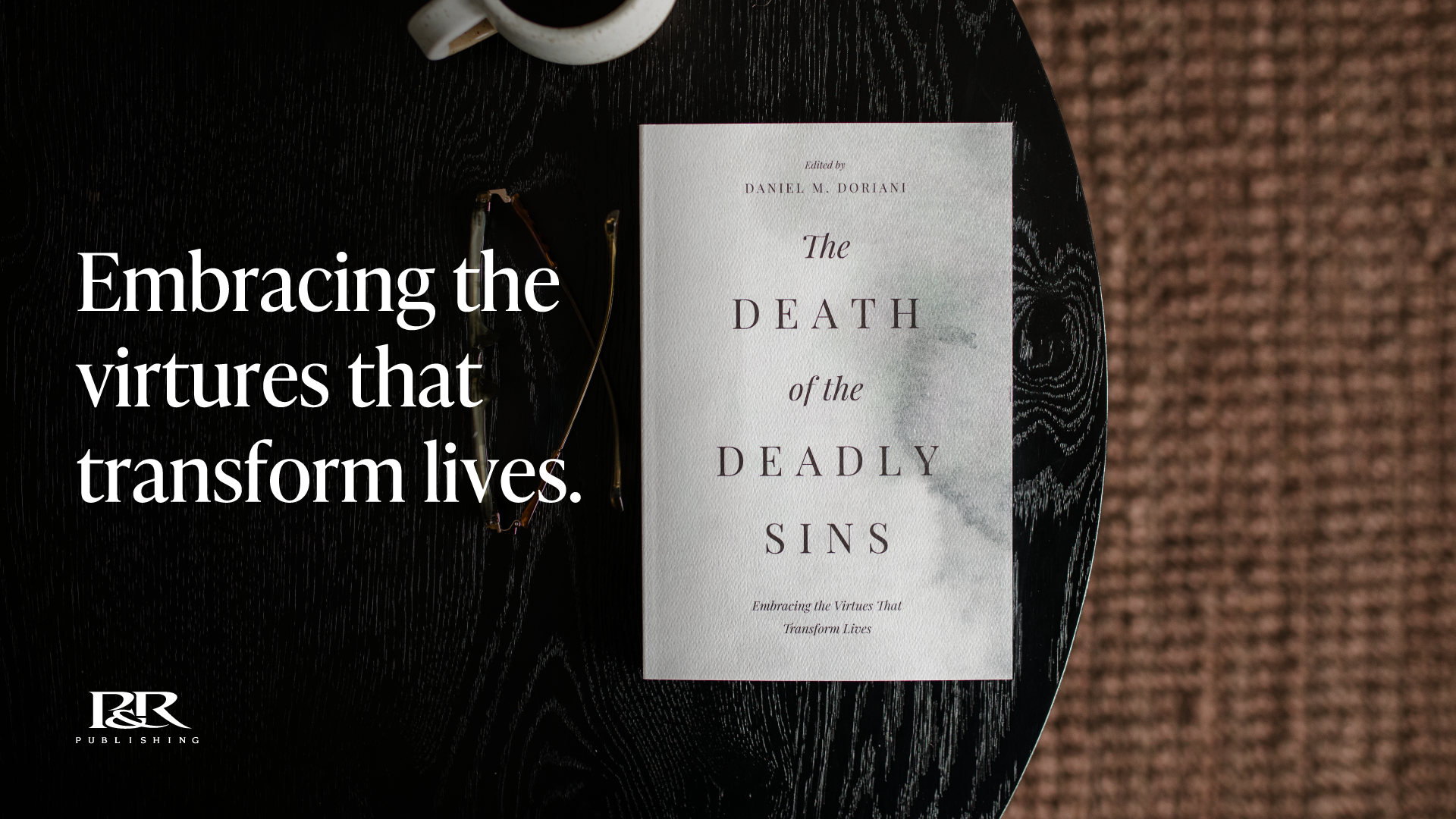 God’s character is the essence of virtue. The heart of virtue is to know the Lord and to become like him, as a child resembles her father. That is the goal, privilege, and destiny of the redeemed. #Sponsored]]>
God’s character is the essence of virtue. The heart of virtue is to know the Lord and to become like him, as a child resembles her father. That is the goal, privilege, and destiny of the redeemed. #Sponsored]]>
This week, the blog is sponsored by P &R Publishing.
Virtue has fallen on hard times. The West has apparently abandoned the idea that leaders ought to be men and women of character. In the past, leaders labored to control their appetites and impulses. Today, many extol men and women who have the resources and boldness to indulge every desire and unleash every impulse.
One day in 2023, the New York Times published two articles that invited readers to abandon the quest to be good. The first article, “I Don’t Need to Be a ‘Good Person,’” urged readers to “listen to your worst instincts and darkest desires.” In the second, “The Virtues of Being Bad,” sixteen writers confessed a range of offenses. At first, it was trivia like eating junk food. More ominously, they lie to strangers, practice shoplifting; and sleep with friends at random.
Judging by widely read advice columns, most Americans live by a code that has just a few rules: Don’t break promises you make to your friends, don’t cheat on your partner (unless you agree on polyamory), and don’t exploit power differentials. People generally do what it takes to be happy—and to help family and friends find happiness, too. So they follow their heart, they cut off people who aren’t “life-giving,” and they seek authenticity.
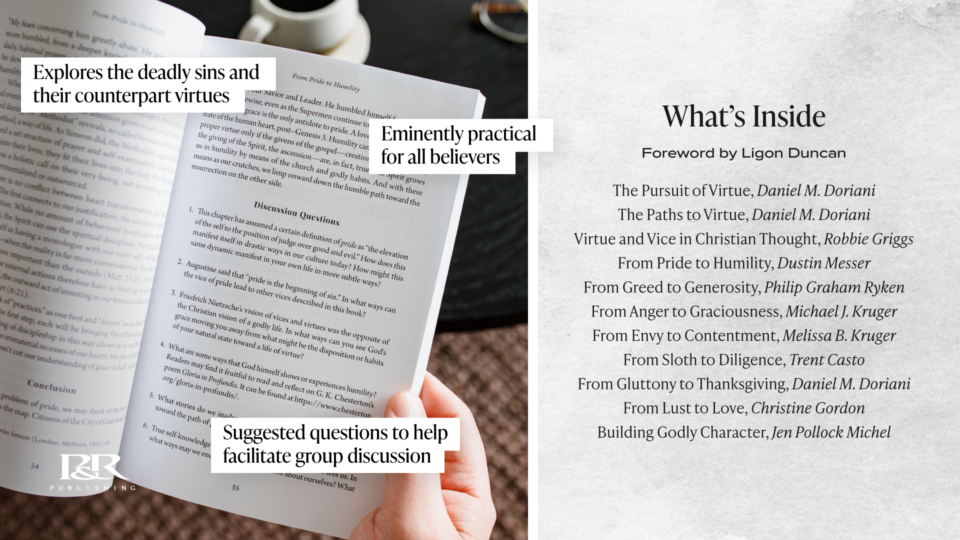
Christians have doubts about virtue, too. Some notice that the Bible speaks of God’s law hundreds of times and barely mentions virtue. The center of Christian morals is “submission to demands. . . . God calls and man obeys.” If that is true, then who needs virtue? All we need is a disposition to obey the law.
Martin Luther also criticized virtue, saying that the journey of the redeemed is not from vice to virtue, but “from virtue to the grace of Christ.” Luther stated that the great enemy of the faith is not the “godless sinner” but the “righteous man” who dwells on his progress and swells with pride.
Indeed, there is a kind of virtue that leads away from Jesus. The Pharisees suffered from it, as we see in Matthew 15:1–20. Clearly, it is time to define true virtue and to make a case for it.
God’s character is the essence of virtue. The heart of virtue is to know the Lord and to become like him, as a child resembles her father. That is the goal, privilege, and destiny of the redeemed. Romans 8:29 informs us that those whom God “foreknew he also predestined to be conformed to the image of his Son.” Believers should gradually resemble Jesus more and more.
To be like Jesus is both our destiny and God’s command. Paul told the Ephesians that they should imitate God: “Be kind to one another, tender-hearted, forgiving one another, as God in Christ forgave you. Therefore be imitators of God, as beloved children. And walk in love, as Christ loved us and gave himself up for us” (Eph. 4:32–5:2). Philippians 2 tells disciples to empty themselves of selfish ambition and self-interest because Jesus did so. From his incarnation to his crucifixion, Jesus “emptied himself” (Phil. 2:7) and humbled himself. We should do the same. In a word, a virtuous person is a lot like Jesus.

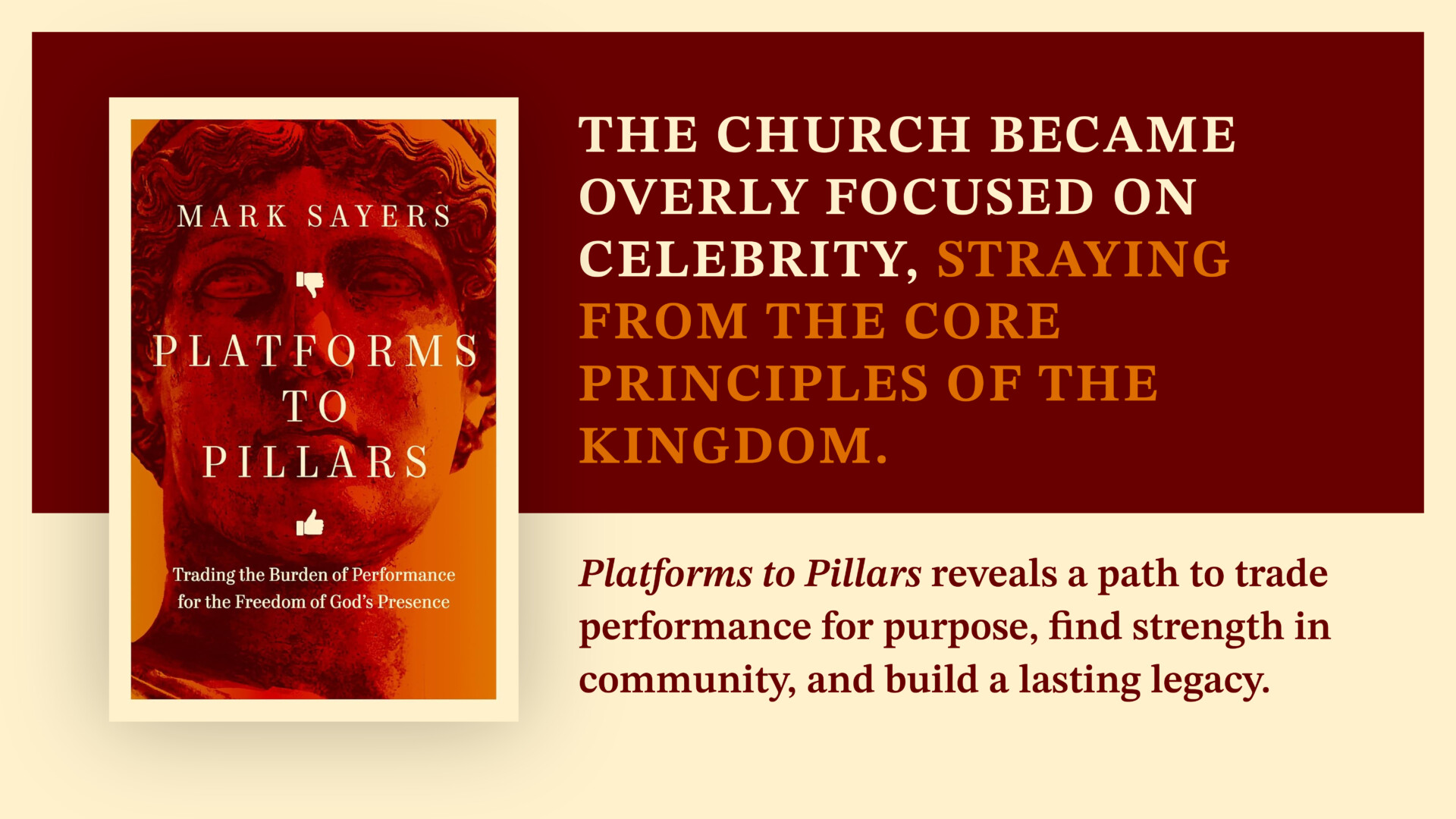 How do we lead in a culture shaped by performance, individualism, and platform?
Platforms to Pillars by cultural commentator Mark Sayers offers a biblical alternative to the platform mentality that dominates our society. Drawing from the ancient world, Sayers challenges Christians to become pillars—people who provide strength and support for others, who live with character and virtue, and who partner with God to advance His kingdom.
This book is a needed call to reject the lure of self-promotion and rediscover the freedom of belonging to God. #Sponsored
]]>
How do we lead in a culture shaped by performance, individualism, and platform?
Platforms to Pillars by cultural commentator Mark Sayers offers a biblical alternative to the platform mentality that dominates our society. Drawing from the ancient world, Sayers challenges Christians to become pillars—people who provide strength and support for others, who live with character and virtue, and who partner with God to advance His kingdom.
This book is a needed call to reject the lure of self-promotion and rediscover the freedom of belonging to God. #Sponsored
]]>
This week, the blog is sponsored by Moody Publishers and is adapted from Platform to Pillars: Trading the Burden of Performance for the Freedom of God’s Presence by Mark Sayers.
A week after I preached my Platforms to Pillars sermon in London, I was leaving a speaking event, feeling exhausted after a brutal season of conflict, betrayal, and discouragement. On this trip, I had the privilege of catching up with other friends who had gone through similar journeys and still longed for God to move. The last few days of my trip filled me with hope, and I prayed that these past days would signal that the long and challenging period I had been walking through would be over.
As I entered St James’s Park tube station, I stood on the platform and rang my wife, Trudi, back home in Australia. Instantly, I could tell that something was wrong. She told me she had gone for a test on a lump in her breast and was called back to the doctor a few days later. “They have done a biopsy on the lump, and it is cancerous.”
I had never felt so far from home as I woke in my hotel room the next day. Yet a remarkable thing began to happen. A truth was revealed to me. Pillars are those who reveal themselves when you need them. They are often hard to see in good times but assemble when the chips are down. Within minutes of waking, friends were calling to offer support. The pastoral team at King’s Cross Church interrupted their schedules to spend the afternoon praying for Trudi and me.
Unable to get an early flight home, I kept my speaking schedule and headed to Oxford to speak at St Aldates Anglican Church. As I walked around Oxford, the streets seemed to give testimony to those pillars who had gone before. I realize the great chain of belief in which I am but a link. Before me have lived great witnesses. Men and women who had walked through suffering, struggle, even martyrdom, yet whose devotion and discipleship still passed the knowledge of God down through the generations.
As I preached my Platforms to Pillars sermon that night, I could feel it was different. This was no longer a theory but a living reality I was stepping into. The pillars felt no longer hidden but incandescent around me, reflecting God’s love.
As we struggled with the news of Trudi’s cancer, the pillars kept appearing around us. Our church rallied in a way I had never seen before. A team of pillars from our church gathered every Monday night to pray for our family as news spread of Trudi’s condition. A wave of prayer began across the world. Amid her pain and the reality of the fragility of her life, Trudi was living as a pillar.
Trudi’s treatment so far has been successful. She now lives from scan to scan, in faith that the cancer will not return, determined to follow God regardless of what the future holds. The suffering, this time of wilderness, has deepened her spiritual authority and sharpened her sense of what is of heavenly value. God has brought around Trudi a new network of those who live and pray as pillars.
Before Trudi’s battle with cancer, I felt discouraged, hurt, and betrayed. I feared for the church’s future and lamented those who had pursued platform and fallen. However, now I see through a different lens. I am amazed by the pillars that fill the church, pointing glory back to God through their lives.
Continue your journey to move beyond platform culture and live as pillars of strength and community.
]]> God wants us to experience the teeming abundance of a life devoted to generative gospel community, even if the spiritual greenhouse is flawed and imperfect. #Sponsored]]>
God wants us to experience the teeming abundance of a life devoted to generative gospel community, even if the spiritual greenhouse is flawed and imperfect. #Sponsored]]>
This week the blog is sponsored by Zondervan Reflective. This was an excerpt from The Reason for Church: Why the Body of Christ Still Matters in an Age of Anxiety, Division, and Radical Individualism. Written by church planter and podcast host Brad Edwards, this book encourages believers to rediscover the goodness and beauty of the Body of Christ.
Whether you struggle to share the gospel with your neighbor, sacrificially love your spouse, pass the faith onto your children, or “love the Lord your God with all your heart and with all your soul and with all your might” (Deuteronomy 6:5), covenant membership is the A-to- Z of reintegrating life and cultivating faith in Christ. Paul says we can hope for and pursue that growth even within a profoundly flawed and imperfect spiritual greenhouse:
I planted, Apollos watered, but God gave the growth. So neither he who plants nor he who waters is anything, but only God who gives the growth. He who plants and he who waters are one, and each will receive his wages according to his labor. For we are God’s fellow workers. You are God’s field, God’s building. (1 Corinthians 3:6–9, emphasis added)
When God created Adam and Eve, he put them in a garden. Not a jungle, a meadow, or some other untamed environment. A garden. Gardens are both organic and ordered ecosystems. Paul understood that when congregations err in the organic direction (“field”), community is too much like a jungle. We expend so much energy fighting for sunlight and nutrients that we don’t have anything left for deepening roots or bearing fruit. A church built on the relational happenstance, preferences, or desires of its members won’t survive its first harsh winter. When churches err on the side of ordered (“building”), you get the perfectly manicured (and boring) gardens of Versailles—plants forced into shapes contrary to their nature. There’s nothing to harvest from this garden because fruit is just too inconvenient and messy to deal with, so the fruit-bearing genes have been bred out of every species. Cultivation isn’t for the plant’s good but for the sake of appearances.
Thankfully, neither ecosystem is what Paul had in mind. Rather, the church is more of an English-style garden,1 positively teeming and bursting at the seams with all manner of life. It may look wild and untamed up close, but its abundance is not the result of neglect or entropy as it may first appear. This garden is the marriage of form and function, splashing color across a monochrome landscape. The harvest is plenty, with enough bounty to share with our neighbors. Nothing is zero-sum. Likeness and difference thrive as part of a mutually dependent, generative whole. You might still see the occasional dandelion, but it’ll stick out like a sore thumb and be uprooted long before it can do any lasting harm. None of that weeding and watering and fertilizing and pruning and waiting (especially the waiting) is in vain because God gives the growth.
God wants so much more for exiles than a dis-integrated way of life. He wants us to experience the teeming abundance of a life devoted to generative gospel community. We don’t have to choose between the dog-eat- dog jungle of radical individualism or being rigidly forced into a Versailles-like conformity unnatural to our design. We can be redeemed and our life reintegrated within this teeming, institutional ecosystem wherein Jesus cultivates apprentice gardeners (disciples) out of potted plants (exiles).
It may be only coincidence, but when Mary Magdalene first encountered Jesus outside the empty tomb, she initially thought he was just ”the gardener” (John 20:15). She wasn’t entirely mistaken either. If God gives the growth, then the church isn’t just a greenhouse for cut flowers. The Divine Gardener is in the business of resurrection. In and through his greenhouse, he brings dead and wilting flowers to life, roots them in fertile soil, and cultivates life-giving faith.
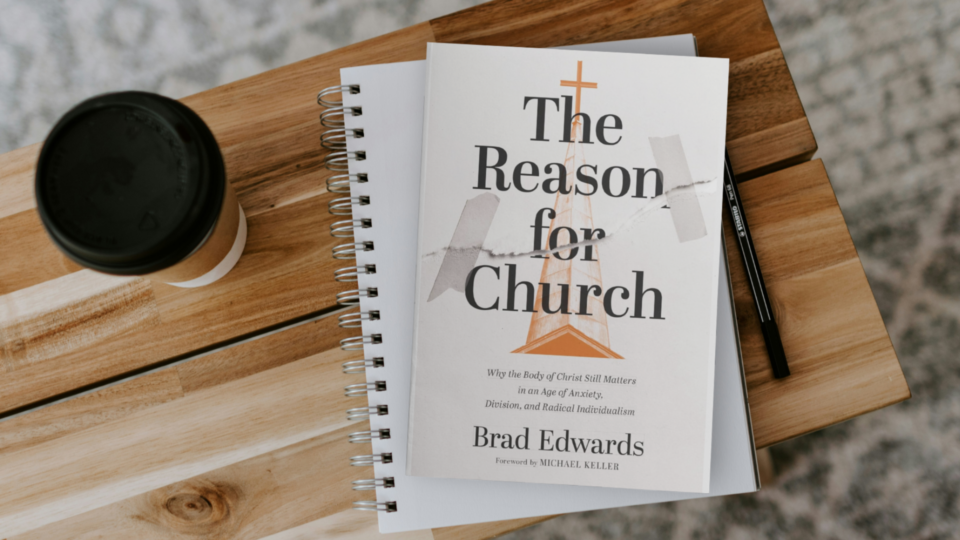
Note
1. I am shamelessly stealing this analogy from Jonah Goldberg, who shamelessly stole it from Friedrich Hayek, who first used it as a metaphor for how free markets cultivate economic growth. It turns out that what’s true of a dynamic in one “oikos” is often universally true across all institutions. Institutions are consistent like that.
]]> At Fieldstone Counseling, we hope to come alongside you and offer lasting hope for life’s hardships through biblically-based, Christ-centered, and clinically informed counsel. #Sponsored]]>
At Fieldstone Counseling, we hope to come alongside you and offer lasting hope for life’s hardships through biblically-based, Christ-centered, and clinically informed counsel. #Sponsored]]>
This week’s blog is sponsored by Fieldstone Counseling. Fieldstone Counseling is a biblical counseling organization based in Northeast Ohio, offering both in-person and remote counseling services. Fieldstone exists to engage life’s experiences with biblically-based, Christ-centered, and clinically informed counsel.
You know you’re an old parent when you find yourself giving quips and quotes that your parents gave you. My kids tell me all the time about how they love my little sayings here and there:
“Are you working hard or hardly working?”
“If you fail to prepare, you prepare to fail.”
“Don’t put off tomorrow what can be done today!”
One of my favorite sayings that I hear often from older generations is:
“An ounce of prevention is worth a pound of cure.”
Meaning, a bit of proactive care on the front end can save you a lot of heartache (and potentially money) in the long run. I find this especially true when it comes to counseling. Often, we think of counseling as reserved for only the most complex or chronic of problems–marriages on the brink of divorce, severe mental health issues, complex parenting situations. Yes, counseling can be helpful in those areas, but it’s also true that counseling can be helpful in the earlier stages of a problem as well.
Counseling provides a context for you to speak and be heard
Sometimes, it’s helpful to speak with someone and be heard. In a culture that is dominated by loud voices and big messages, sometimes your personal story of sin and shame, suffering and sorrow gets lost in the mix. When did you last speak with someone about what was on your heart? When was the last time you had the chance to talk to someone about something of essential importance in your life? Counseling can provide that!
Counseling can help you see early signs of danger
I’ve been told that early detection is the key to many of life’s physical health issues. A friend recently told me that I need to keep an eye on my rising blood pressure as that could be an indicator of cardiovascular issues. Trust me–I’m taking his counsel very seriously. Similarly, counseling can help you process and receive biblical guidance and truth on issues in your life before they become overwhelming or life-dominating.
Struggling with every day, low-level anxiety? Stuck in a rut at work and struggling to find meaning and purpose? Why not seek a wise counselor to work through these issues with?
Counseling can identify blind spots
In speaking and being heard, counseling can also help you identify those pesky blind spots in your life. What you might see as a difficult relationship actually ties back to a past hurt or trauma in a previous relationship. That persistent feeling of loneliness could be connected to insecurities about being rejected or abandoned by friends and loved ones. The bad news about blind spots is that they can cause serious accidents if you ignore them. The good news about blind spots is that an accident can be avoided simply by being aware of them.
Counseling can help you connect the truths of Scripture with the troubles of life
What happens in the counseling room? I think you’d be surprised at how simple and straightforward counseling actually is. We speak to each other from the heart, and then we seek to connect those important realities to the truth of who Christ is and the hope offered to us in Scripture. In Scripture, we see ourselves clearly for who we are–sinners and sufferers in need of God’s grace and mercy.
In light of this, take a moment and pause. Is there something in your life right now that you could use some solid, biblical counsel on? Is there someone in your life right now that you need help navigating difficult dynamics with? Take that ounce of prevention now–consider reaching out for help. Fieldstone Counseling is a biblically-based, Christ-centered, and clinically informed counseling center that offers its services to people looking for lasting hope for life’s hardships.
Visit us today and make an appointment at fieldstonecounseling.org

 The Photo Companion to the Bible illustrates every book in the New Testament through beautiful, high-quality digital photographs. Especially designed for use by Bible teachers and church leaders, this PowerPoint-based resource includes explanatory notes and is easily adaptable to your needs. Your download includes generous usage permissions that cover the home Bible study, the classroom, and the sanctuary.]]>
The Photo Companion to the Bible illustrates every book in the New Testament through beautiful, high-quality digital photographs. Especially designed for use by Bible teachers and church leaders, this PowerPoint-based resource includes explanatory notes and is easily adaptable to your needs. Your download includes generous usage permissions that cover the home Bible study, the classroom, and the sanctuary.]]>
This week the blog is sponsored by BiblePlaces.com. This post features a Q&A with Dr. Todd Bolen, professor of Biblical Studies at The Master’s University and the founder of BiblePlaces.com.
How do photographs help in studying and teaching the Bible?
First of all, the Bible is a record of real history, of God working in the lives of real people and real places. Photos immediately reduce the distance between here and there, now and then. Second, photographs help us to understand God’s Word more accurately, instead of relying on our imaginations to fill in the details. What does the Mount of Olives look like? How big were the synagogues Jesus taught in? What is the terrain like where the Good Samaritan loved his beaten-up Jewish neighbor? A picture can often answer these questions more effectively than a thousand words.
How did you get involved in creating photo collections to illustrate the Bible?
I lived and taught at our university’s campus in Israel for more than a decade. Traveling to the biblical sites again and again gave me the opportunity to take tens of thousands of photos. I rented airplanes so I could fly over and photograph biblical sites, and I traveled extensively to other countries throughout the Middle East to photograph everything relevant to Scripture. While many of these photos have been used in study Bibles, atlases, and archaeology magazines, the heart of our team’s mission is to provide Bible students and teachers with high-quality images that help to explain and illustrate the biblical text.
How can a student or teacher use photographs to enhance their understanding of Scripture?
One place to start is by looking at photographs of biblical sites. If you are reading about Capernaum, it helps to see pictures of the village’s situation on the shore of the Sea of Galilee. The synagogue where Jesus preached and the house where Peter lived are better understood when looking at photographs of these places. Similarly, artifacts from the ancient world can be very illuminating, such as slave chains, a Roman sword, or a silver denarius. In the old days, books would give descriptions of these artifacts, but now we have the technology that makes it easy to view and display large quantities of high-resolution full-color images.
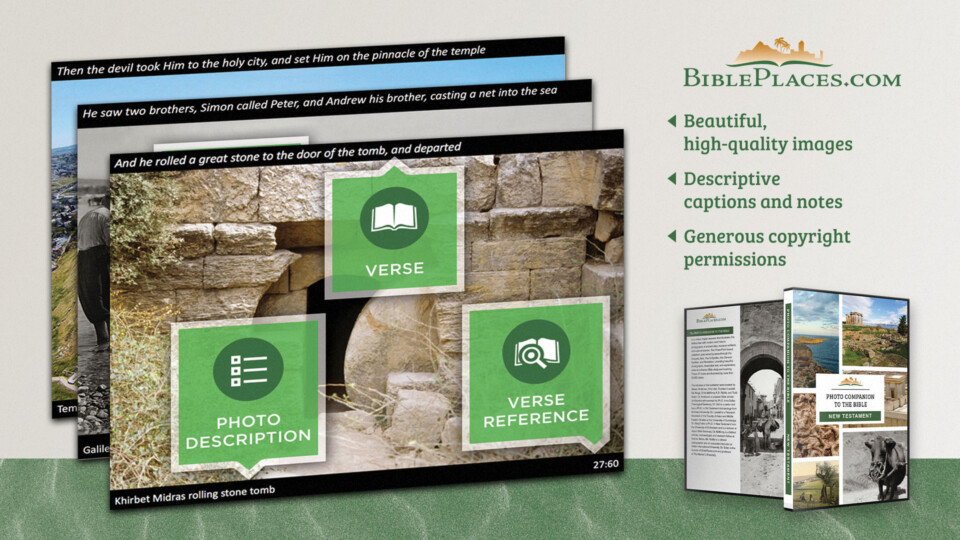
Can modern photographs really help us to understand the ancient world?
Absolutely! Many things look today as they did 2,000 years ago. Landscapes of Galilee where Jesus walked and Greece where Paul traveled are virtually unchanged. Many ancient sites have been excavated and some have been reconstructed. Museum artifacts also help us to get a glimpse into the past. Something else quite valuable are historic images taken 100–150 years ago that peel back the layers of modern construction. Altogether, we have a remarkable advantage today in understanding the ancient world that was not possible prior to the invention of photography and recent technologies that make the distribution of digital images quite affordable.
Why is the Photo Companion to the Bible useful to Bible students and teachers?
I am a professor and a Sunday School teacher, and our team is made up of others who also love and teach the Bible. We know what the busy Bible teacher needs. The Photo Companion to the Bible is carefully organized, so you can find all the relevant photos just by looking up the chapter and verse you are studying. For example, if you are learning about the parables of Matthew 13, you’ll find more than a hundred images of sowers, wheat fields, dragnets, and valuable pearls.
Our collections are designed for those who have not traveled to Israel or other biblical countries, and we provide explanatory notes that give important details about what the image is and why it is significant. The PowerPoint format is ideal because it brings together the photo, the description, and the explanation all in one place, and those using PowerPoint for teaching can easily copy and paste the slides into their own presentations.
Our photo collections are also affordable, with hundreds or thousands of photos in each volume. The purchaser is granted broad permission to use these pictures in their Bible studies, classrooms, and churches. That eliminates the concern of wondering about copyright violations when you are grabbing an image from some website or Google search.
Why not just use images available from a Google search?
Five reasons: time, quality, accuracy, knowledge, and legality. Searching for the right image can burn up precious time, and when you multiply that by weeks of study and preparation, that adds up to a significant investment of time. Second, the quality of internet images varies widely. Our images are the best of the best of 30 years of living and traveling throughout the biblical world. Third, you can’t believe everything you read on the internet! Images are sometimes misidentified, and if you are not an expert you won’t necessarily know what’s right and what’s wrong. Our team of biblical scholars ensures accuracy in every detail. Fourth, the average pastor or professor, as trained as they are, doesn’t even realize the possible illustrations that exist. You can’t find what you don’t know to look for. Finally, there may be copyright restrictions that require you to seek permission or make payment. Our collections avoid all of that hassle.
What is available now and what are you working on next?
Our first collection was the Pictorial Library of Bible Lands, a 20-volume set that provides photos organized by biblical region, from Galilee to Greece and more. Our newest collection is the Photo Companion to the Bible, and we have completed the entire New Testament. We have also finished most of the historical books of the Old Testament, including Genesis, Exodus, Joshua through 2 Kings, Ezra, Nehemiah, Esther, and Daniel. We’re working this year on Job, Ecclesiastes, and Song of Solomon. It’s really astonishing just how much of the Bible can be illustrated with photographs. Our university students love these, as do those we teach in our churches, and we love to see other pastors and teachers get excited when they realize the possibilities!
The Photo Companion to the Bible is available now. Check out our special offers now.

 Many people feel AI is too complicated to be of use, or they fear that AI might produce generic, low-quality, or inauthentic content. However....]]>
Many people feel AI is too complicated to be of use, or they fear that AI might produce generic, low-quality, or inauthentic content. However....]]>
This week the blog is Sponsored by Strider, a Christian-owned online marketing agency. Ryan Freeman has been helping to grow local businesses and non-profits for over 30 years. Book a free consultation with Ryan to learn if Strider is a fit for your goals.
In the 90s, clients wondered if a website was really necessary. Business email? You must be crazy! Ten years later, e-commerce was lunacy and social media was just going to be a fad. You can imagine (or maybe you remember!) the introduction of mobile phones, texting, and then smartphones!
Artificial Intelligence (AI) is the new shiny object, and once again I’m seeing a very natural hesitation when it comes to change. Many people feel AI is too complicated to be of use, or they fear that AI might produce generic, low-quality, or inauthentic content. However, when implemented thoughtfully, AI can help to streamline repetitive tasks and enhance creative work without compromising authenticity. Here’s how you can harness AI to boost your business’s efficiency while maintaining genuine engagement.
Dos and Don’ts: Maximizing AI’s Potential
1. Crafting Effective Prompts
Don’t: Use vague prompts like “Write me an article about widgets.” This will give you generic content that fails to resonate with your audience and sounds like a robot wrote it..
Do: Provide detailed instructions to your AI tools. For example:
- Audience: Specify who you’re addressing (e.g., small business owners).
- Tone: Define the desired tone (e.g., authoritative yet friendly). Bonus: Point to previous articles you’ve written so that the AI can learn your style.
- Purpose: Clarify the objective of the content (e.g., to inform, persuade, or entertain).
This approach ensures the AI generates content that aligns with your business’s voice and goals.
Here’s an example of a quick but useful starter prompt for a blog post.
You are a marketing copywriter with deep experience in the dental medical care industry.
Help me to write a blog post promoting the importance of regular dental checkups for children. The audience is parents with children under 16 years old. Use a friendly tone and authoritative tone to show you have knowledge and experience while being relatable and empathetic. Use headings and bullet points so it’s easy to read.
Give citations for any data or facts that you use.
Suggest some ideas for graphics.
2. Managing Online Reviews
Don’t: Ignore customer reviews or respond with generic, copy-pasted replies. That’s a great way to broadcast that you don’t care about your customers.
Do: Utilize AI to draft personalized responses to each review. AI can analyze the review’s sentiment and content, assisting you in crafting thoughtful replies that address specific customer feedback. Edit the draft to add your final touches before you publish. This personalized approach demonstrates that you value customer input and are committed to continuous improvement.
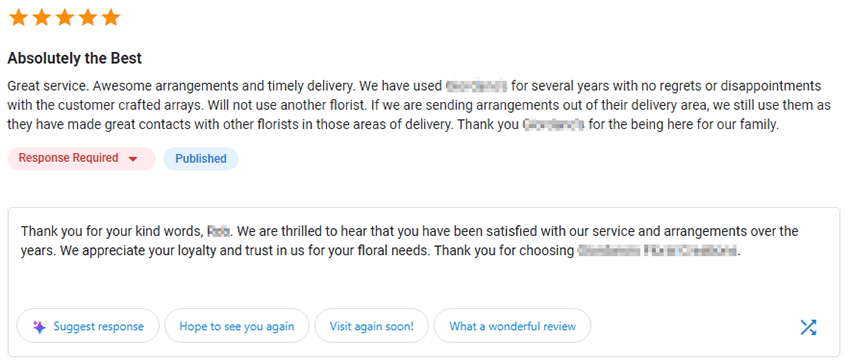
3. Creating Unique Visual Content
Don’t: Rely solely on common stock images that other businesses also use. This can make your brand appear generic and uninspired.
Do: Leverage AI to generate custom photos, illustrations, and graphics. AI-driven design tools can create visuals tailored to your brand’s identity, setting you apart from competitors and enhancing your visual storytelling.
Here’s the first prompt I used to create the featured image for this post. Because of the conversational nature of ChatGPT, I was able to guide it through many revisions.

4. Enhancing Social Media Engagement
Don’t: Post sporadically or wait for free moments to come up with content, leading to an inconsistent and less engaging social media presence.
Do: Use AI to assist in crafting engaging posts, generating unique images, and scheduling content for consistency. This proactive approach keeps your social media channels vibrant and relevant.

5. Improving Customer Service
Don’t: Implement live chat features on your website without proper monitoring and staffing, resulting in delayed replies or missed messages.
Do: Add an AI website agent trained on your specific business information to handle customer inquiries in real-time. AI-powered chatbots can conversationally answer frequently asked questions, provide product information, and capture lead details efficiently. Additionally, consider using an AI receptionist to manage overflow calls, ensuring no customer query goes unattended.

We Can Help
Integrating AI into your business doesn’t mean sacrificing authenticity. With the right strategies, AI can enhance efficiency, personalize customer interactions, and drive growth. If you’re thinking about trying AI and online marketing to attract and convert more customers, contact me for a chat. The Strider team is here to help you navigate the evolving digital landscape and achieve sustainable profitability – whether you’re a one-person entrepreneur or a growing team of 40+
PS: To write this article, I created a bulletpoint outline, gave ChatGPT a prompt about the purpose and audience for the post, and then edited the text.
]]> The truth is that we all have some work to do. Healthy disagreement will draw all of us beyond our natural strengths. It will require stretching into new (often uncomfortable) territory.]]>
The truth is that we all have some work to do. Healthy disagreement will draw all of us beyond our natural strengths. It will require stretching into new (often uncomfortable) territory.]]>
This week the blog is sponsored by The Good Book Company, publisher of The Art of Disagreeing by Gavin Ortlund. In this positive and practical book, Gavin Ortlund looks to the Scriptures to discover a way to disagree with courage and kindness. You can purchase The Art of Disagreeing here.
There is a theory in social psychology about two contrasting ways in which people deal with disagreement. Essentially, about half of human beings act like rhinoceroses: the other half, like hedgehogs. Rhinos are aggressive, charging when threatened. Hedgehogs are more defensive, using their prickles as a shield. One book puts it like this:
“Just as animals respond differently to attack, so people react differently when hurt and angry. There are two major patterns of behaviour, and … it would appear that the population is split roughly fifty-fifty. Half of the population are like the rhino: when they
are angry, they let you know it. The other half of the population are like the hedgehog: when they feel angry, they hide their feelings.”
Whether you adopt this exact framework or not, it draws attention to an important fact: when it comes to challenging conversations or relationships, we all have different temptations. So disagreement will challenge all of us in different ways.
If you are a rhino, healthy disagreement will be difficult because it requires more restraint than you would naturally be inclined to show. You may have moments when you feel like “charging,” and it might even feel like the right thing to do—but you actually need to tap the brakes. (Often we realize this only afterwards, once the temperature has cooled!)
But if you’re a hedgehog, healthy disagreement will be difficult because it requires more boldness than you would naturally be inclined to show. You may have moments when you feel like hiding, but you actually need to embrace the vulnerability of leaning forward into the disagreement. Where you would normally pull back, you have to speak up. This can be scary! It rubs against our natural preference for harmonious relationships.
To make matters worse, hedgehogs and rhinos will often be tempted to look down on each other while ignoring their own weakness. The opposing flaws will be obvious to us, while our own will seem small or invisible. A rhino might look at a hedgehog and say, “Why doesn’t he speak up more? I know he agrees, but he lacks the courage to say so!” Conversely, a hedgehog might look at a rhino and say, “Why is she so argumentative? She turns everything into a fight!” Both might be (partly) right. This is one way that outrage about disagreement can contribute to further disagreement and outrage, without us realizing it.
The truth is that we all have some work to do. Healthy disagreement will draw all of us beyond our natural strengths. It will require stretching into new (often uncomfortable) territory.
For this reason, the ability to engage in healthy disagreement is a good general test of maturity. If you want to see how much self-awareness someone has, just watch how they respond to a good old-fashioned disagreement.
]]>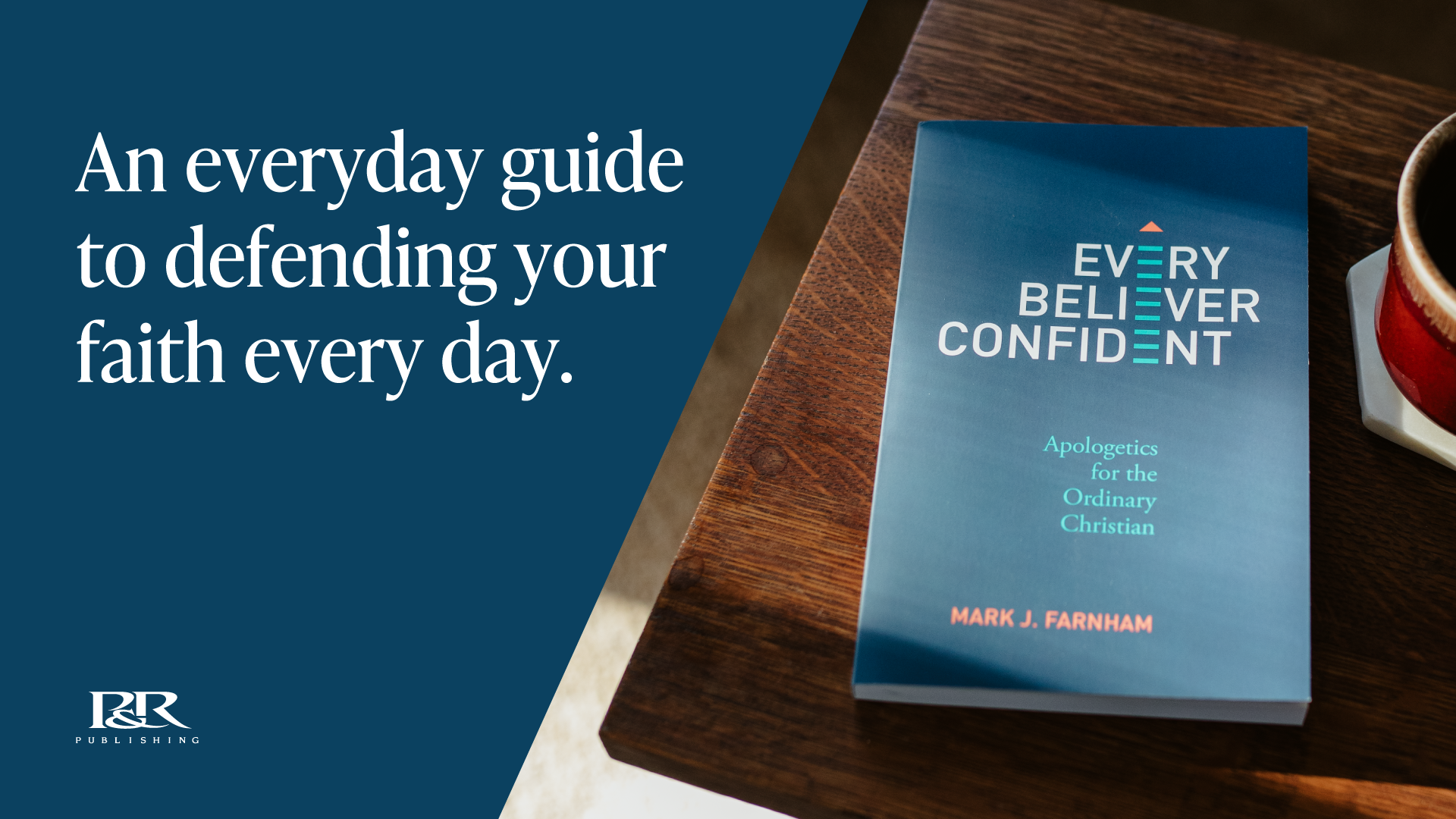 You may have a burden for the lost and a desire to learn to defend your faith but can’t see yourself becoming a philosopher or scientist to do so. I have good news. You don’t have to! Ordinary Christians can become skilled and effective evangelists.
]]>
You may have a burden for the lost and a desire to learn to defend your faith but can’t see yourself becoming a philosopher or scientist to do so. I have good news. You don’t have to! Ordinary Christians can become skilled and effective evangelists.
]]>
This week the blog is sponsored by P&R Publishing.
You may have a burden for the lost and a desire to learn to defend your faith but can’t see yourself becoming a philosopher or scientist to do so. I have good news. You don’t have to!
Being a good evangelist or apologist does not require you to obtain an academic degree or read obscure texts. Jesus never commanded his disciples to go to Athens to learn at the feet of philosophers in order to reach the world. While knowing a little about philosophy, science, and other fields of study may help, extensive knowledge in these areas is not necessary. Ordinary Christians can become skilled and effective evangelists.
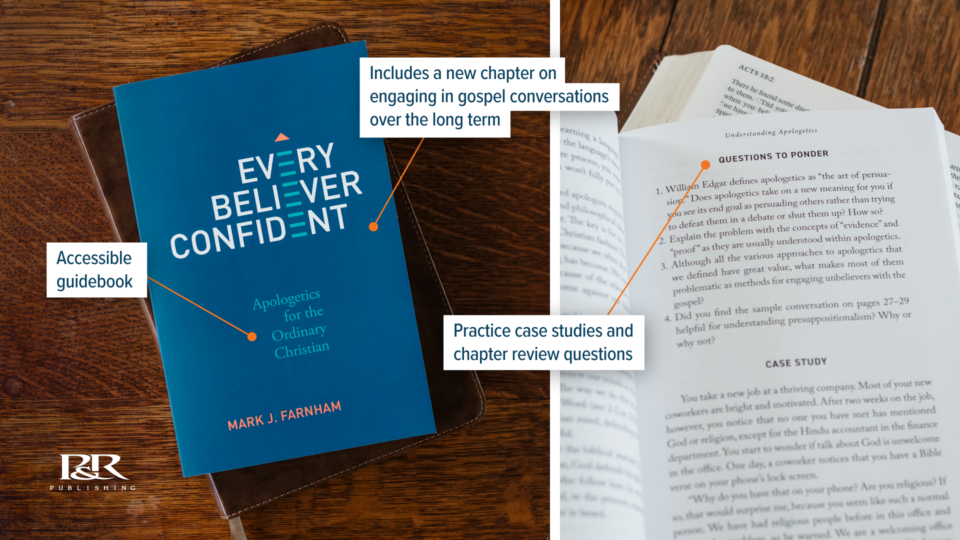
Whatever your background, you can learn to defend the faith, share the gospel, shake the unbelief of non-Christians, present the Christian worldview, and lead people to saving faith in Jesus Christ.
“Marvelously clear, practical, and emboldening. Excellent guidance for anyone who seeks to be more faithful and effective in gospel advance.” —Fred G. Zaspel
That is what this book is all about: equipping you with the confidence and skills you need to fulfill the Great Commission (Matt. 28:19–20), give an answer to those who question you (1 Peter 3:15–16), and declare the mystery of Christ (Col. 4:3–4). If you simply want to reach your unbelieving neighbors, friends, coworkers, family members, and classmates, this book is for you!
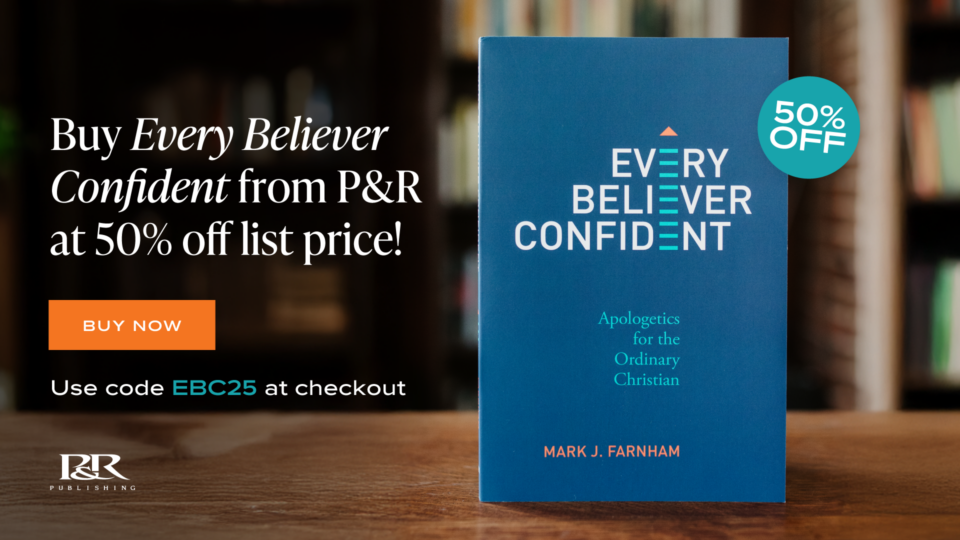
Use coupon code EBC25 at checkout.
]]> It is not simply that we as a culture have lost our knowledge of God, but that in so doing we have also lost sight of ourselves. “Who am I?” is the question of the age.]]>
It is not simply that we as a culture have lost our knowledge of God, but that in so doing we have also lost sight of ourselves. “Who am I?” is the question of the age.]]>
This week’s blog, written by Daniel Stevens, is sponsored by the D3 Conference. Dr. Stevens, a professor at Boyce College, will teach during the breakout sessions at the March 27–28, 2025 youth conference in Louisville, Kentucky.
“Nearly all the wisdom we possess, that is to say, true and sound wisdom, consists of two parts” wrote John Calvin in Institutes of Christian Religion, “the knowledge of God and of ourselves.”
If this is so, ours is a profoundly unwise age. It is not simply that we as a culture have lost our knowledge of God, but that in so doing we have also lost sight of ourselves. “Who am I?” is the question of the age. We are doubly adrift, with no sense of God to anchor our understanding of the world, and no true sense of self to ground us within our own lives.
Instead, we are spent in the fruitless project of trying to create ourselves. We craft personalities on social media, presenting exactly the pictures and words we want projected. We pick subjects in school and aim at careers that we think will give us meaning, that will lead us to find ourselves, to make ourselves. We are burdened more than we can bear as we try to tell the world, and then tell ourselves, who we really are.
But there is a better way.
Jesus calls out to each and every one of us, “Come to me, all who labor and are heavy laden, and I will give you rest” (Matt. 11:28). He tells us that if we do, we will find life and have it abundantly (John 5:40, 10:10), that if we die to ourselves, losing our life for his sake, then we will truly save our lives (Matt. 10:39, 16:25, Mark 8:35, Luke 9:24). In following Jesus, we not only find him, we find ourselves. We not only receive His life, we are truly given our own lives as well. We find ourselves not in an endless pursuit of self-expression, but in being found by Jesus. We receive ourselves from him.
During the D3 Youth Conference, your student will hear clear, Scripture-based answers to help them stand firm in their faith. Join us March 7-8, 2025 as we seek to grow our understanding and application of God’s Word as our foundation for clarity and truth.
To learn about topics discussed during D3, click the link below: https://www.d3youth.com/conference-schedule
]]> The Christian Standard Commentary will encourage and equip God’s people to understand the text and live according to Scripture for Christ's glory. The unique ancient-modern approach to the biblical text found in the CSC is a valuable resource for building up Christ’s church while encouraging God’s people to fulfill the Great Commission. As a commentary series written with Christ’s church in mind, the CSC is a valuable tool for the shelves of pastors, scholars, and any student of Scripture.]]>
The Christian Standard Commentary will encourage and equip God’s people to understand the text and live according to Scripture for Christ's glory. The unique ancient-modern approach to the biblical text found in the CSC is a valuable resource for building up Christ’s church while encouraging God’s people to fulfill the Great Commission. As a commentary series written with Christ’s church in mind, the CSC is a valuable tool for the shelves of pastors, scholars, and any student of Scripture.]]>
This week the blog is sponsored by Lifeway, with the Christian Standard Commentary. Get 40% off on Lifeway.com when you use the promo code CHALLIESCSC40 after putting items into your cart. Does not apply to eBooks or pre-orders.
With the availability of so many great commentaries on the Bible, what sets the Christian Standard Commentary (CSC) apart from others? The CSC aims to embody an “ancient-modern” approach to each volume in the series. This approach seeks to balance the strengths of the modern commentary tradition with the lesser known, and highly beneficial, dynamics of the ancient commentary tradition, bringing together the old and new to give a biblically derived and theologically rich commentary steeped in history.
The modern commentary tradition arose and grew rapidly during and after the Protestant Reformation (ca. 1517–1600). The growth of the biblical commentary tradition is largely a result of three factors:
(1) The recovery of classical learning in the fifteenth and sixteenth centuries. This retrieval led to a revival of interest in the biblical languages (Hebrew, Aramaic, and Greek). Biblical scholars, pastors, and teachers interpreted Scripture based on the biblical languages rather than the Latin Vulgate.
(2) The rise of reformation movements and the splintering of the Catholic Church. The German Reformation (Martin Luther), Swiss Reformation (John Calvin), and English Reformation (Anglican), among others (e.g., Anabaptist), generated commentaries that helped new churches and their leaders interpret and preach Scripture with clarity and relevance, often with the theological distinctives of the movements present in the commentaries.
(3) The historical turn in biblical interpretation in the seventeenth and eighteenth centuries. This turning point emphasized the historical background from which biblical books arise and in which they are contextualized. Both preachers and teachers sought to interpret the Bible within this framework as they emphasized Scripture alone (sola Scriptura).
Additionally, over the last fifty years the modern commentary tradition experienced a shift with the development of literary analysis in biblical interpretation. Developed in the 1970s and 1980s, literary analysis significantly influenced the shape and content of modern biblical commentaries by giving attention to the structure and style of each section in a biblical book. It also paid close attention to the shape of the book as a whole. Because of this influence, modern commentaries assess a biblical book’s style and structure, major themes and motifs, and how style influences meaning. Literary interpretation recognizes that biblical books are works of art, arranged and crafted with intentional structure and purpose.
Although the CSC affirms the traditional features of a modern commentary while seeking to explore the unique literary dimensions of the biblical books, it is especially marked by a theological bent regarding biblical interpretation. This bent recognizes that the Bible is not only a historical or literary document but is fundamentally the Word of God. It recognizes Scripture as both historical and theological. God is the primary speaker in Scripture, and readers must deal with Him.
Theological interpretation affirms that although God enabled many authors to write the books of the Bible (Heb 1:1), He is the divine author, the subject matter of Scripture, and the One who gives the Old and New Testaments to the church, the people of God, to facilitate her growth for her good (2 Tim 3:16–17).
Theological interpretation reads Scripture as God’s address to His people because God gives Scripture to His people to be heard and lived. Any other approach (whether historical, literary, or otherwise) that diminishes emphasis on theological interpretation stands deficient before the demands of the text.
Common to Christian biblical interpretation in the past two millennia (e.g., patristic, medieval, reformation, or modern) is a vision of Scripture in which Scripture is read with attention to divine activity, truth, and relevance to the people of God. The ancient commentary tradition interprets Scripture as a product of complex and rich divine action. God has stepped into history and given his Word to his people so that they may know, love, and glorify Him, and proclaim His praises to all creation, leading to spiritual and practical transformation.
The transformative nature of Scripture emerges in the ancient commentary tradition as it attends to the centrality of Jesus Christ. Jesus is the One whom God sent to the world in the fullness of time and is the One to whom the OT anticipates, testifies, and witnesses. Furthermore, he is the One whom the NT presents as the fulfillment of the OT promise, in whom the church lives and moves and has her being (see Acts 17:28), and who the Old and New Testaments testify will return to judge the living and the dead and who will, one day, make all things new (Rev 21:5).

With Christ as the center of Scripture, the ancient commentary tradition reveals an implicit biblical theology. The Old and New Testaments work together as they reveal Christ; thus, the tradition works within a whole-Bible theology in which each testament is read as Christian Scripture.
Finally, the ancient commentary tradition is committed to spiritual transformation. The Spirit of God illumines the hearts of readers so that they might hear God’s voice, see Christ in His glory, and live in and through the power of the Spirit. The transformational dimensions of Scripture emerge in ancient commentary so that God’s voice might be heard anew in every generation and God’s Word might be embodied among His people for the sake of the world.
In Scripture, God speaks to reveal Christ and call the church to live by faith in His world. God’s people need both the theological emphasis of the ancient tradition as well as the historic-literary emphasis found in modern commentaries. In balancing both, this “ancient-modern” approach provides a commentary that will encourage and equip God’s people to understand the text and live according to Scripture for Christ’s glory. The unique approach to the biblical text found in the Christian Standard Commentary is a valuable resource for building up Christ’s church while encouraging God’s people to fulfill the Great Commission, to which all are called. As a commentary series written with Christ’s church in mind, the CSC is a valuable tool for the shelves of pastors, scholars, and any student of Scripture.
]]>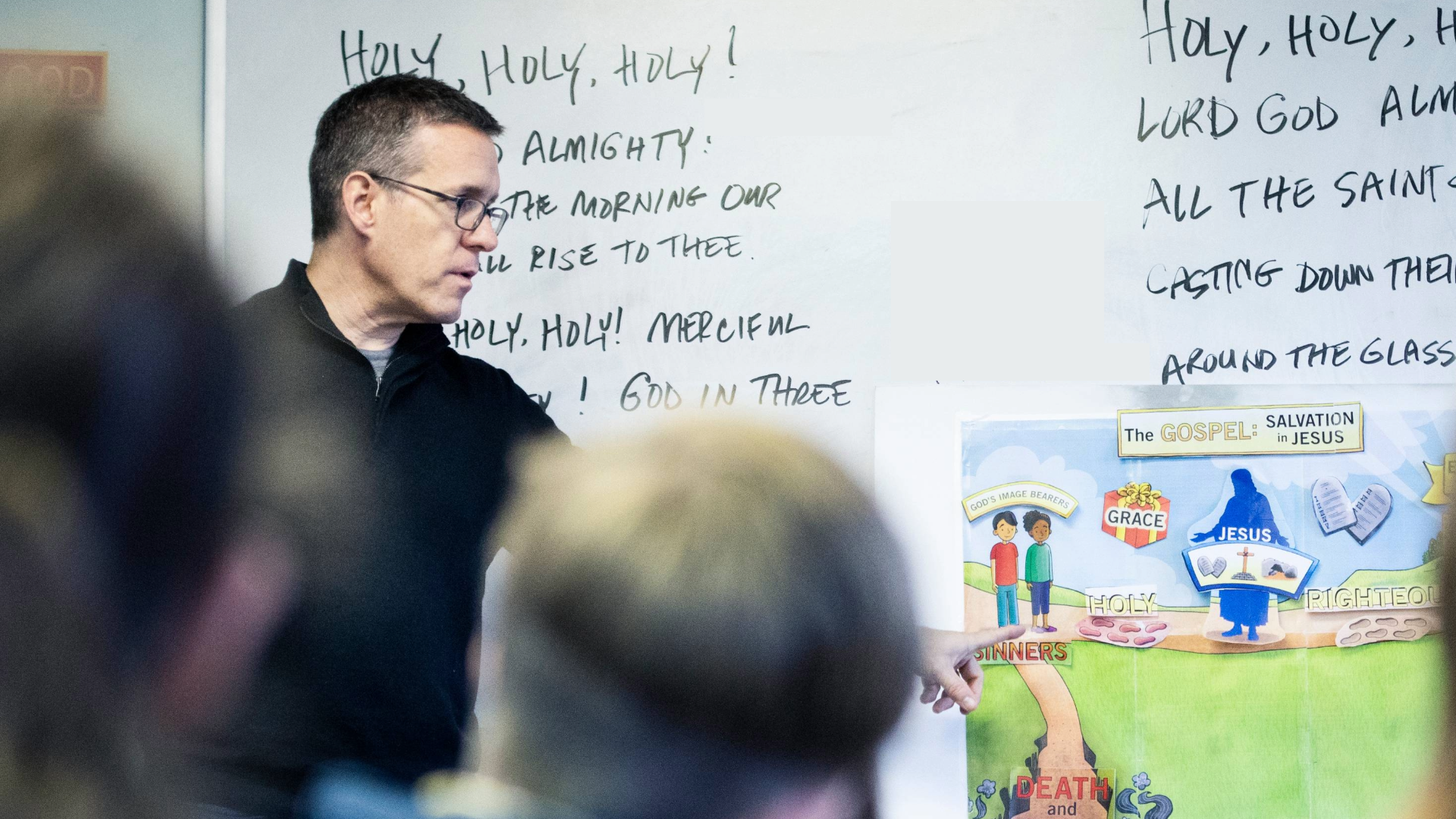 📖 Why teach children the big truths of the Bible?
Moses commanded Israel to gather everyone—men, women, and little ones—to hear God’s law. Why? So they could "hear and learn to fear the Lord." (Deut. 31:12-13)
Children need the deep, rich truths of Scripture to know God, embrace the Gospel, and build a faith that stands firm. Discover 10 compelling reasons why teaching children big truths matters more than ever.
]]>
📖 Why teach children the big truths of the Bible?
Moses commanded Israel to gather everyone—men, women, and little ones—to hear God’s law. Why? So they could "hear and learn to fear the Lord." (Deut. 31:12-13)
Children need the deep, rich truths of Scripture to know God, embrace the Gospel, and build a faith that stands firm. Discover 10 compelling reasons why teaching children big truths matters more than ever.
]]>
This week the blog is sponsored by Truth78.
Moses commanded Israel’s priests and elders to gather the people every seven years and read the law to them. What is surprising are his instructions, “assemble the men, women, and little ones.” The little ones! The whole law? Yes. And Moses makes his reasoning clear: “that they may hear and learn to fear the Lord your God, and be careful to do all the words of this law, and that their children who have not known it, may hear and learn to fear the Lord your God…” (Deuteronomy 31:12-13)
Children still need to be taught the big truths of the Bible. Here are ten reasons why:
- Children Need an Accurate View of God and the Bible
Emphasizing one aspect of God’s character while neglecting others distorts their view of who God is. For example, teaching the law without grace leads to believing that salvation is by works; emphasizing grace without justice can give the impression that sin is trivial, and everyone will be saved. - Children Need Big Truths in Order to Embrace the Gospel
Grace makes no sense without understanding sin, and sin doesn’t make sense without understanding God’s holiness. Children need an adequate understanding of the gospel in order to respond in faith. (1 Peter 1:23). - Knowing the Word is a Foundation for Wisdom and Holiness
Children cannot fear or love God if they don’t know who He is. Right thinking leads to right living. (Proverbs 9:10; Psalm 119:11) - Children Are Open to Hard Truths
Children are often black-and-white thinkers, unhindered by past emotional baggage. When they learn truth early, they develop a theological framework to inform their experiences, instead of letting experience shape their theology. - Children Have Tender Hearts
We have a window of opportunity to teach truth before their hearts become resistant. (2 Timothy 4:2-4) It is easier to mold a tender heart than a calloused heart. - Children Need a Biblical Framework
Big truths help children make sense of life through the lens of God’s providence. - Early Maturity Can Prevent Wrong Thinking
It’s easier to teach children right theology from the start than to undo wrong thinking when they’re adults. Limiting children to “easy” doctrines can stunt their spiritual growth may lead to a crisis of faith when suffering and disappointments come later in life. (Hebrews 5:12-14) - Discernment Comes through Practice
The same tender hearts that incline them to truth can also make them vulnerable to error. The greatest weapon against lies is knowing the truth. (Hebrews 5:14; Colossians 2:1-4) - Children Need an Accurate Self-Perception
Children are self-righteous and self-centered. The Scriptures show them their desperate need of rescue and transformation. - Deep Theology Prepares Children to Stand Steadfast
Children need a theology of suffering to prepare them for the inevitable storms of life. (John 15:18-20; James 1:12)
Children need parents and pastors and Sunday School teachers to teach them the whole Bible–the big, deep, weighty, glorious truths, even the challenging parts–if they’re going to put their trust, unshakably, in Christ.
Explore resources for teaching children the big truths they need and start a free trial of Truth78 curriculum. https://truth78.org/big-truths
]]> This week the blog is sponsored by Burke Care. Those who fear you shall see me and rejoice, because I have hoped in your word. Psalm 119:74 With the year ending, we were recently invited to a small gathering about 30 minutes away from where we live. We met the usual traffic delays getting to the house. It was already dark due to the shortened daylight hours in fall. It was a misting rain, the kind you get in the South in December. We arrived safe and comfortable. The conversation was delightful, and it was fun to hear about everyone’s family and the recent updates since we had last met. Each household there attends different churches so there were updates on community and upcoming events and plans. I had taken a moment prior to that evening to think about being invited to such a gathering. My past has not always included being invited to such a gathering. Redemption has taken place in my life and attending such a meal with such godly men and women as not always been part of my past. It is not often that I proactively consider being part of such an occasion. But this time, I did think about the relevance of being invited to such a gathering. I even awkwardly tried to express my gratitude to being included in such a grace-filled, redemptive family gathering of brothers and sisters in Christ. It is important to note that without Jesus’s intervention in my life, I would not be a part…]]>
This week the blog is sponsored by Burke Care. Those who fear you shall see me and rejoice, because I have hoped in your word. Psalm 119:74 With the year ending, we were recently invited to a small gathering about 30 minutes away from where we live. We met the usual traffic delays getting to the house. It was already dark due to the shortened daylight hours in fall. It was a misting rain, the kind you get in the South in December. We arrived safe and comfortable. The conversation was delightful, and it was fun to hear about everyone’s family and the recent updates since we had last met. Each household there attends different churches so there were updates on community and upcoming events and plans. I had taken a moment prior to that evening to think about being invited to such a gathering. My past has not always included being invited to such a gathering. Redemption has taken place in my life and attending such a meal with such godly men and women as not always been part of my past. It is not often that I proactively consider being part of such an occasion. But this time, I did think about the relevance of being invited to such a gathering. I even awkwardly tried to express my gratitude to being included in such a grace-filled, redemptive family gathering of brothers and sisters in Christ. It is important to note that without Jesus’s intervention in my life, I would not be a part…]]>
This week the blog is sponsored by Burke Care.
Those who fear you shall see me and rejoice, because I have hoped in your word. Psalm 119:74
With the year ending, we were recently invited to a small gathering about 30 minutes away from where we live. We met the usual traffic delays getting to the house. It was already dark due to the shortened daylight hours in fall. It was a misting rain, the kind you get in the South in December.
We arrived safe and comfortable. The conversation was delightful, and it was fun to hear about everyone’s family and the recent updates since we had last met. Each household there attends different churches so there were updates on community and upcoming events and plans.
I had taken a moment prior to that evening to think about being invited to such a gathering. My past has not always included being invited to such a gathering. Redemption has taken place in my life and attending such a meal with such godly men and women as not always been part of my past. It is not often that I proactively consider being part of such an occasion. But this time, I did think about the relevance of being invited to such a gathering.
I even awkwardly tried to express my gratitude to being included in such a grace-filled, redemptive family gathering of brothers and sisters in Christ. It is important to note that without Jesus’s intervention in my life, I would not be a part of such a moment. I verbalized my thankfulness to the group which was met with polite deflecting, but I was honest. Me being invited to such an event is an enormous testimony to what God has done in my life that should not go unnoticed.
It is humbling to consider that Jesus came down from his throne in heaven to provide a way for God to reconcile His children back to Himself. Even though I was His enemy, “He loved me.”
The saying is trustworthy and deserving of full acceptance, that Christ Jesus came into the world to save sinners, of whom I am the foremost. – 1 Timothy 1:15 ESV
For if while we were enemies we were reconciled to God by the death of his Son, much more, now that we are reconciled, shall we be saved by his life. – Romans 5:10 ESV
For God so loved the world, that he gave his only Son, that whoever believes in him should not perish but have eternal life.
– John 3:16 ESV
“Those who fear you…” I was born into a family that feared others more than they feared God. They taught me that what other people thought of me was more important that following the God of the Bible. I am eternally grateful that the Holy Spirit responded to God’s call on my heart and resurrected me from being “dead in my trespasses.” (Eph 2:5).
“…shall see me and rejoice,” It is a joy to sit and share a meal with my brothers and sisters in Christ. My new family teaches me, loves me, cares for me, corrects me, encourages me, and enjoys me. This is no small miracle knowing where I have been in my past. It is a mystery as to how God has started, been committed to, and is dedicated to bringing my transformed life to completion. (Phil 1:56)
“…because I have hoped in your word” The common denominator in all of us around the dinner table that evening was our love for the God of the Bible. The Truth of Scripture found in the person of Jesus Christ is where our hope lies. It is Jesus’ return that keeps us actively waiting, abiding in faith, hope, and love. (1 Cor 12:13)
As the Advent season of waiting ends and the infant Jesus has arrived in the manger in Bethlehem on Christmas, we enter a new liturgical season. “The Feast of Epiphany celebrates the appearing of the Son of God among us as one of us – both fully divine and fully human.” *
I encourage you to take inventory of how God’s presence in your life has changed you and those around you. I pray that the revelation of the God of the Bible in your life will shine forth and you will see more clearly the path God has you on, for His glory and your good.
If you have more questions about your life and the friend group you find yourself with, Burke Care would love to talk with you. We would love to hear your story.
*Desiring God, “The Irony of the Epiphany” by David Mathis
Father God, thank you for adopting me into your family and putting so many wonderful people around me. I need You and I need healthy, safe community around me. I want to love You more and to love those You have placed around me more. Grant me all the love, grace, and peace to walk in this calling You have on my life. Amen.
…even when we were dead in our trespasses, made us alive together with Christ—by grace you have been saved… – Ephesians 2:5 ESV
And I am sure of this, that he who began a good work in you will bring it to completion at the day of Jesus Christ. – Philippians 1:56 ESV
So now faith, hope, and love abide, these three; but the greatest of these is love. – 1 Corinthians 13:13 ESV
Application Questions:
- In what ways do I still feel shame about the things I do and the crowd I run with?
- How can I break from my life of former sin and walk in the truth of God’s grace in my life?
- God, are you good? Why do I run back to the things I do not want to do so easily?
To learn more about Burke Care or find a counselor, you can go to www.burkecare.org. You can find more Psalm 119 blog posts at Care thru Psalm 119 — Burke Care
Schedule Care Today | Info@burkecare.org | 512.522.2580 | Subscribe
 This week the blog is sponsored by Into the Word and is written by Pastor Paul Carter. No matter how you plan to read the Bible in 2025, Into the Word wants to help! Into the Word began in 2017 with a simple mission: to help people read, love and live the whole counsel of God. Toward that end, we try to provide “pastor level” guidance to our listeners, as we walk together, verse by verse and chapter by chapter through whole books of the Bible. As of December 1st, 2024 we have covered 563 chapters, or approximately 47% of the Bible. God willing, we will pass through the 50% mark in 2025. Each chapter episode is between 15-25 minutes in length, depending on the number of verses in the text. I typically read 4-5 commentaries on the book in question and then prepare the transcripts. I record the episodes, and after a bit of light editing from our tech team, we release them on the date they appear in the RMM Bible Reading Plan, but of course, you can use the episodes with any reading plan, or with no plan at all. The entire library of episodes can be found on the Into the Word app or on the Into the Word website. Recently released episodes can be found on iTunes, Google Play, Spotify, or wherever you find your podcasts. People ask me from time to time, why in the world I am doing this. I am a full-time pastor. I’ve got 5 kids.…]]>
This week the blog is sponsored by Into the Word and is written by Pastor Paul Carter. No matter how you plan to read the Bible in 2025, Into the Word wants to help! Into the Word began in 2017 with a simple mission: to help people read, love and live the whole counsel of God. Toward that end, we try to provide “pastor level” guidance to our listeners, as we walk together, verse by verse and chapter by chapter through whole books of the Bible. As of December 1st, 2024 we have covered 563 chapters, or approximately 47% of the Bible. God willing, we will pass through the 50% mark in 2025. Each chapter episode is between 15-25 minutes in length, depending on the number of verses in the text. I typically read 4-5 commentaries on the book in question and then prepare the transcripts. I record the episodes, and after a bit of light editing from our tech team, we release them on the date they appear in the RMM Bible Reading Plan, but of course, you can use the episodes with any reading plan, or with no plan at all. The entire library of episodes can be found on the Into the Word app or on the Into the Word website. Recently released episodes can be found on iTunes, Google Play, Spotify, or wherever you find your podcasts. People ask me from time to time, why in the world I am doing this. I am a full-time pastor. I’ve got 5 kids.…]]>
This week the blog is sponsored by Into the Word and is written by Pastor Paul Carter. No matter how you plan to read the Bible in 2025, Into the Word wants to help!
Into the Word began in 2017 with a simple mission: to help people read, love and live the whole counsel of God. Toward that end, we try to provide “pastor level” guidance to our listeners, as we walk together, verse by verse and chapter by chapter through whole books of the Bible. As of December 1st, 2024 we have covered 563 chapters, or approximately 47% of the Bible. God willing, we will pass through the 50% mark in 2025. Each chapter episode is between 15-25 minutes in length, depending on the number of verses in the text.
- To listen to a sample Old Testament episode, see here.
- To listen to a sample New Testament episode, see here.
- To listen to an entry level series that is perfect for new believers, see here.
- To listen to a series that unpacks a complicated Old Testament book, see here.
I typically read 4-5 commentaries on the book in question and then prepare the transcripts. I record the episodes, and after a bit of light editing from our tech team, we release them on the date they appear in the RMM Bible Reading Plan, but of course, you can use the episodes with any reading plan, or with no plan at all. The entire library of episodes can be found on the Into the Word app or on the Into the Word website. Recently released episodes can be found on iTunes, Google Play, Spotify, or wherever you find your podcasts.
People ask me from time to time, why in the world I am doing this. I am a full-time pastor. I’ve got 5 kids. I’m 50 years old. This project has already taken me 8 years and will probably take 10 more to complete. So why in the world am I doing this?
I guess the simple answer is that I can’t imagine not doing it. I was 18 years old the first time I read through the whole Bible from cover to cover and from that point on, I was hooked. Every time I read the Bible I felt like I understood it a little better. Each time I made it through the whole thing, all the individual stories and parts made more sense to me. I read the Bible to learn about God, to learn about me, and to learn about how God saved me through the person and work of Christ. My life’s passion is to share what I’ve found and experienced with others. I think of myself as a sort of “Bible Guide”. By God’s grace I’ve had the opportunity to study the history and the languages of the Bible and to spend the better of my life so far in teaching and sharing it with others. I do that most of the time in my home church, but I use the Into the Word radio and podcast program to help people all around the world read, love and live the whole counsel of God. I would love to serve you in any way I can, however you plan on reading and studying the Scriptures in 2025.
Some people use Into the Word to help them stay on track with their Bible Reading Plan. They’ll read two chapters of the Bible in the morning, and then listen to one or two episodes of Into the Word in the car on the way to work. Some couples listen to Into the Word together for their morning devotions. Some people use it as the basis for a mid-week Bible Study and discussion group. However you plan to use it – or even if you don’t – I pray that the Lord would bless you richly as you read and study the Scriptures throughout the coming year. May your time in the Word feed your soul, guide your steps, transform your character, and grow your love for Jesus Christ.
And may God alone be glorified!
To find the complete library of Into the Word episodes by Pastor Paul see here. To read his most recent articles over at TGC Canada see here.
]]>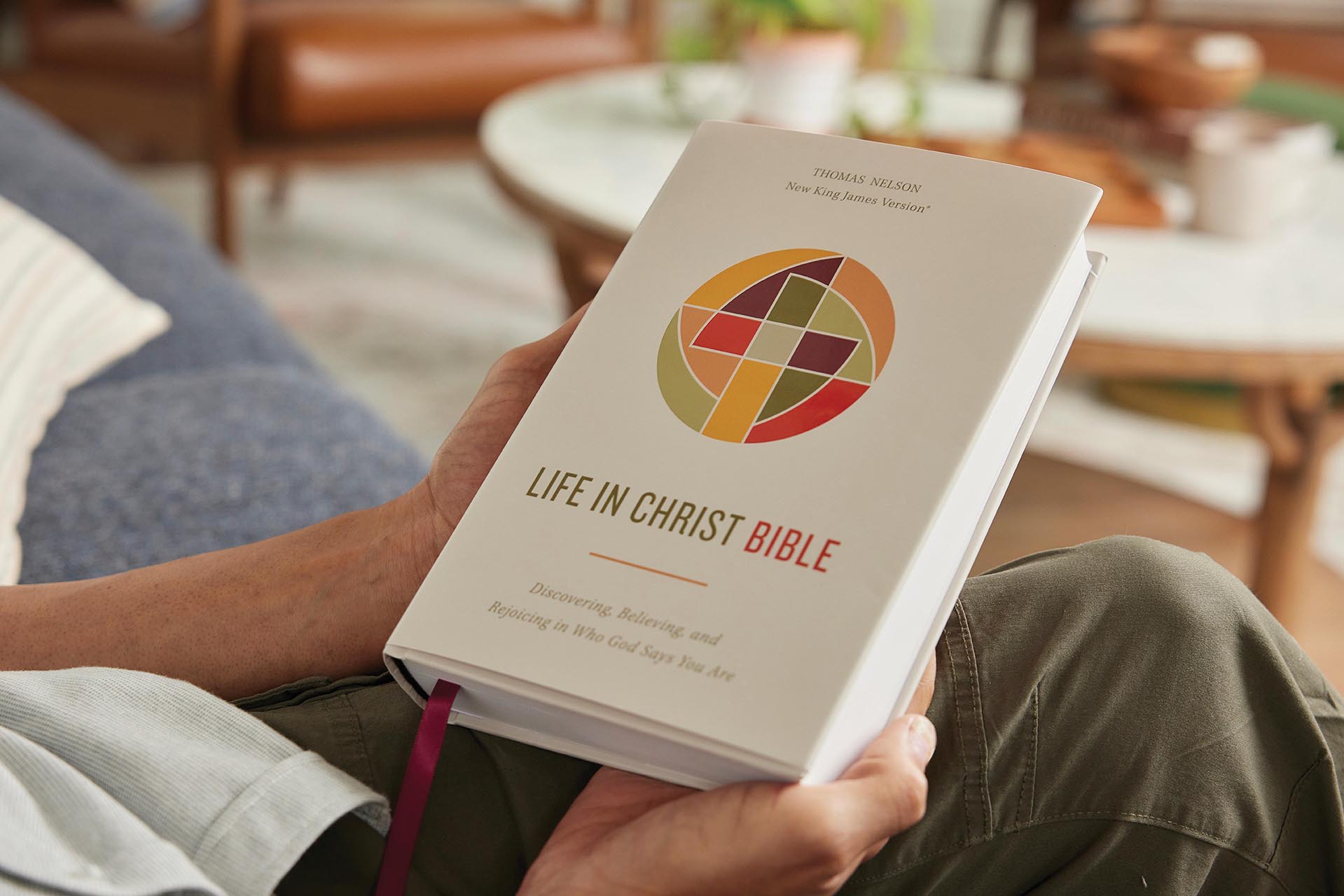 Identity matters for at least two key reasons. First, understanding our identity—our true God-given identity—is vital to understand why we exist and what we’re to do in life, as it is likewise essential for framing a fitting perspective of others.]]>
Identity matters for at least two key reasons. First, understanding our identity—our true God-given identity—is vital to understand why we exist and what we’re to do in life, as it is likewise essential for framing a fitting perspective of others.]]>
This week the blog is sponsored by Thomas Nelson Bibles and the Life in Christ Bible. This post features a Q&A with Brian Dembowczyk, Associate Publisher of Thomas Nelson Bibles, about how our lives are shaped by the stories we believe about our identities.
Brian, why does the concept of identity matter?
Identity matters for at least two key reasons. First, understanding our identity—our true God-given identity—is vital to understand why we exist and what we’re to do in life, as it is likewise essential for framing a fitting perspective of others. God created us as his image-bearers, unique from the rest of creation. This gives us, and everyone else, intrinsic value and points us to what we’re to do in life—basically to glorify God in all we do. While the specific ways we glorify God might vary for individuals, timeframes, locations, and cultures, that overarching goal is fixed for all of us. But to know how we are to do that, we need to know who we are. What we do should always come from who we are. And as Christians, we are image-bearers who have been made new in Christ. Christ not only saves us from sin, but he also gives us the capacity and the power to live as we were truly made to live.
Second, identity matters because we’re seeing increasing questions and distortions about it, both in our culture and in the church. “Who am I” is a question that has been asked since humans have existed, and it’s taking new forms today. So many people have questions. So many people are confused and hurting. So many people are looking for answers—answers that are found in Scripture.
Christians have written a great deal about this issue. How do you see this Bible adding to the conversation?
It’s true that much has been written on identity; it’s also true that much more can and should be written about it. While our basic understanding of identity is unchanged because it is based on unchanging Scripture, how we relate to this subject can change as culture changes. The Life in Christ Bible seeks to walk that balance of pointing readers to the unchanging nature of identity, while also speaking to modern issues related to it. More than that though, this Bible seeks to help readers see how interconnected this subject is with all of Scripture. This isn’t just a secondary doctrine; it’s a major one that the Bible addresses from cover to cover.
What aspect of this Bible are you most excited about?
That would have to be the identity notes, about one thousand brief notes showing how the subject of identity runs throughout Scripture. These notes are organized in three categories: (1) notes that show who everyone is as an image-bearer, (2) notes that show who we are as those made new in Christ, and (3) notes that show how we are to live out our God-given, Christ-restored identity. The hope is that these notes imbed identity-related orthodoxy (right thinking), orthopathy (right feeling), and orthopraxy (right living) in the reader.
How do you see this Bible encouraging people who are trying to navigate the many cultural conversations around identity?
There’s an adage that when you know the genuine article, you can spot any fake. For example, if you know real U.S. currency—the feel and look of the paper, the design, the ink used, and so forth—then you can recognize any counterfeit because it doesn’t measure up to the standard. That’s the big win of this Bible: Readers will come to know genuine identity and in doing so, they will be able to recognize any counterfeit identity they have given themselves or that has been given by others. That includes not just distortions of identity that we see today, but also improper priorities on secondary identity markers. But this Bible also features several chained articles on subjects that we believe will aid readers to navigate these contemporary conversations.
What takeaways do you hope people gain from reading and studying Scripture using the Life in Christ Bible?
In addition to what’s been shared, another takeaway would be for readers to find peace and joy in who they are. One of the guiding principles of crafting the content for this Bible was the goal that each time a reader closes this Bible, they should do so with a smile and with a sense of awe of God’s goodness. Another major takeaway was for readers to do something with their growing understanding of identity. Our faith is a performative faith—it is active. That means every time we go to God’s Word, we should walk away better motivated and aware of how to live more like who God made us to be and who we’ve been remade in Christ.
The Life in Christ Bible is available now. Learn more and try a free six-day reading plan at lifeinchristbible.com.
]]>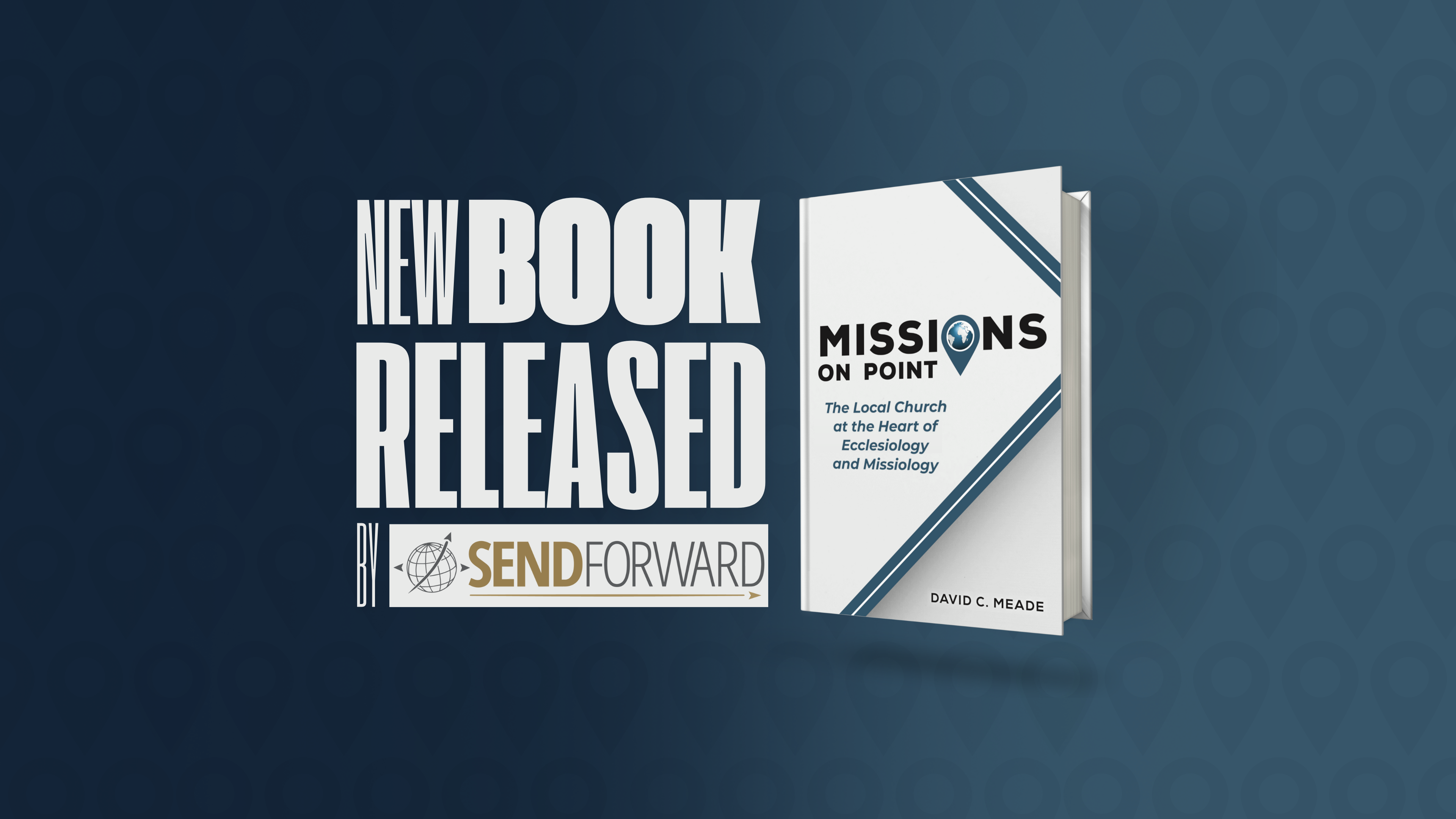 This week the blog is sponsored by Propempo International which invites you to explore a revolutionary take on missions on today! What would happen if the local church took its rightful role in global missions? Providing a refreshing look on missions, “Missions on Point,” written by experienced church planter and missionary David Meade, proposes this simple thesis: This thesis encourages the repatriation of missions to the biblical local church-centered framework. “Missions on Point” presents the biblical defense of church-centered missions. Then, it outlines principles for implementation by local churches and all those involved in missionary training and sending. “Missions on Point” will include some anecdotes of churches we’ve helped to become aligned with this teaching. Woven through the book is an illustrative, composite serial narrative of “Hopewell Bible Church” based on real experiences. It is all based on real-life situations, anonymized for privacy and security purposes. That story fleshes out the highlights of applying the principles presented. The book also has plenty of resources in the Appendices for further study and development. The goal is to align missions with its core priority. Missions begins and ends with local churches. On earth, our goal is for believers to worship Christ together in healthy, indigenous churches. The way to achieve it is through the sending church’s ownership of missions ministries, which results in better-equipped missionaries, less attrition from the field, and more effective, long-term field ministries for the glory of God alone. The position proposed by “Missions on Point” does not imply that local sending churches do all…]]>
This week the blog is sponsored by Propempo International which invites you to explore a revolutionary take on missions on today! What would happen if the local church took its rightful role in global missions? Providing a refreshing look on missions, “Missions on Point,” written by experienced church planter and missionary David Meade, proposes this simple thesis: This thesis encourages the repatriation of missions to the biblical local church-centered framework. “Missions on Point” presents the biblical defense of church-centered missions. Then, it outlines principles for implementation by local churches and all those involved in missionary training and sending. “Missions on Point” will include some anecdotes of churches we’ve helped to become aligned with this teaching. Woven through the book is an illustrative, composite serial narrative of “Hopewell Bible Church” based on real experiences. It is all based on real-life situations, anonymized for privacy and security purposes. That story fleshes out the highlights of applying the principles presented. The book also has plenty of resources in the Appendices for further study and development. The goal is to align missions with its core priority. Missions begins and ends with local churches. On earth, our goal is for believers to worship Christ together in healthy, indigenous churches. The way to achieve it is through the sending church’s ownership of missions ministries, which results in better-equipped missionaries, less attrition from the field, and more effective, long-term field ministries for the glory of God alone. The position proposed by “Missions on Point” does not imply that local sending churches do all…]]>
This week the blog is sponsored by Propempo International which invites you to explore a revolutionary take on missions on today!
What would happen if the local church took its rightful role in global missions?
Providing a refreshing look on missions, “Missions on Point,” written by experienced church planter and missionary David Meade, proposes this simple thesis:
- The Bible teaches that God has always planned to declare His wisdom and glory through local churches.
- The New Testament shows local churches as the quintessential means and ends of His design for proclaiming the Gospel to every people group on earth.
- Missions ministries on the field and all stakeholders of the global missions enterprise would be more effective if aligned with this understanding.
This thesis encourages the repatriation of missions to the biblical local church-centered framework. “Missions on Point” presents the biblical defense of church-centered missions. Then, it outlines principles for implementation by local churches and all those involved in missionary training and sending.
“Missions on Point” will include some anecdotes of churches we’ve helped to become aligned with this teaching. Woven through the book is an illustrative, composite serial narrative of “Hopewell Bible Church” based on real experiences. It is all based on real-life situations, anonymized for privacy and security purposes. That story fleshes out the highlights of applying the principles presented. The book also has plenty of resources in the Appendices for further study and development. The goal is to align missions with its core priority. Missions begins and ends with local churches.
On earth, our goal is for believers to worship Christ together in healthy, indigenous churches. The way to achieve it is through the sending church’s ownership of missions ministries, which results in better-equipped missionaries, less attrition from the field, and more effective, long-term field ministries for the glory of God alone.
The position proposed by “Missions on Point” does not imply that local sending churches do all the equipping, sending, field management, and shepherding on their own. It does, however, awaken and challenge church leaders, missions leaders, missionaries, and everyone involved in the support and administration of missions to align with God’s plan for His glory in and through the local church. All stakeholders are offered suggestions for adjusting practices to a more biblical local-church-centered reality. These principles have been proven by a thoughtful examination of biblical values, decades of experience in the missionary field, cross-cultural missions leadership, and local church pastoral experience.
Though most missions organizations founded their organization to serve local churches in the missions’ geographical, cultural, institutional, or technical specialty, they typically become independent in operation and in calling, which they unashamedly protect, promote, and propagate. Yet, they expect churches to support the agency rather than vice versa. Rarely does the agency enable and facilitate the local church’s missions ministry. Vision, field strategy, personnel management, and accountability have become the agency’s exclusive realm. Missions agencies may too easily show little or no respect for the rightful role of the local church in missions.
Local churches bear some blame here. They have too easily given up their biblical role and responsibility to missions agencies (even to denominational entities). Local churches should reclaim their ownership. It’s prime time for them to repatriate world missions to the local church while seeking appropriate partnerships with sending agencies to lend their particular expertise. This book aspires to provide a pathway to corrective change in this state of affairs.
Buy your copy of this revolutionary take on missions on Amazon today!
]]> This week’s blog is sponsored by Insight Counseling, providing counsel, care, and training in the grace and power of Christ. Click here to find out more. Remember how the Lord your God led you all the way in the wilderness these forty years, to humble and test you in order to know what was in your heart, whether or not you would keep his commands.He humbled you, causing you to hunger and then feeding you with manna, which neither you nor your ancestors had known, to teach you that man does not live on bread alone but on every word that comes from the mouth of the Lord. (Deut. 8:2-3) I recently planted shrubs to create a little healthy privacy between neighbors’ yards (Prov. 25:17), and I had to find some very different types of plants that would grow under the same conditions of light, water, and temperature. Only time will tell if they can grow side by side and flourish together for the desired result. These growing plants are very much like the qualities God intends to cultivate in us. He often makes surprising pairings that serve as a sign that gospel growth is present. He pairs humility and strength (Matt. 5:5), scarcity and contentment (Phil. 4:12), pain and joy (Heb. 12:2), as well as many others, to draw our hearts to the kind of growth that is uniquely Spirit-driven. Deuteronomy 8 does just the same thing as God reminds His people that the twin fruits He intends to produce from their wilderness journey are resilience and dependence. He granted them a humbling hunger that often took…]]>
This week’s blog is sponsored by Insight Counseling, providing counsel, care, and training in the grace and power of Christ. Click here to find out more. Remember how the Lord your God led you all the way in the wilderness these forty years, to humble and test you in order to know what was in your heart, whether or not you would keep his commands.He humbled you, causing you to hunger and then feeding you with manna, which neither you nor your ancestors had known, to teach you that man does not live on bread alone but on every word that comes from the mouth of the Lord. (Deut. 8:2-3) I recently planted shrubs to create a little healthy privacy between neighbors’ yards (Prov. 25:17), and I had to find some very different types of plants that would grow under the same conditions of light, water, and temperature. Only time will tell if they can grow side by side and flourish together for the desired result. These growing plants are very much like the qualities God intends to cultivate in us. He often makes surprising pairings that serve as a sign that gospel growth is present. He pairs humility and strength (Matt. 5:5), scarcity and contentment (Phil. 4:12), pain and joy (Heb. 12:2), as well as many others, to draw our hearts to the kind of growth that is uniquely Spirit-driven. Deuteronomy 8 does just the same thing as God reminds His people that the twin fruits He intends to produce from their wilderness journey are resilience and dependence. He granted them a humbling hunger that often took…]]>
This week’s blog is sponsored by Insight Counseling, providing counsel, care, and training in the grace and power of Christ. Click here to find out more.
Remember how the Lord your God led you all the way in the wilderness these forty years, to humble and test you in order to know what was in your heart, whether or not you would keep his commands.He humbled you, causing you to hunger and then feeding you with manna, which neither you nor your ancestors had known, to teach you that man does not live on bread alone but on every word that comes from the mouth of the Lord. (Deut. 8:2-3)
I recently planted shrubs to create a little healthy privacy between neighbors’ yards (Prov. 25:17), and I had to find some very different types of plants that would grow under the same conditions of light, water, and temperature. Only time will tell if they can grow side by side and flourish together for the desired result. These growing plants are very much like the qualities God intends to cultivate in us. He often makes surprising pairings that serve as a sign that gospel growth is present. He pairs humility and strength (Matt. 5:5), scarcity and contentment (Phil. 4:12), pain and joy (Heb. 12:2), as well as many others, to draw our hearts to the kind of growth that is uniquely Spirit-driven.
Deuteronomy 8 does just the same thing as God reminds His people that the twin fruits He intends to produce from their wilderness journey are resilience and dependence. He granted them a humbling hunger that often took them to the brink of destruction, ultimately producing a strength and perseverance in them that would endure. However, the trial wasn’t pushing them to dig deeper into themselves and their inner resolve but to make them more aware of their utter dependence on God and His mercy. True gospel growth never gives us the sense that we are able to withstand more and more with less and less difficulty. Rather, it expands our awareness that we need “every word that comes from the mouth of the Lord” in times and places we never even knew before.
Biblical counseling, like most counseling, begins with a sense that a person needs greater strength and resilience to navigate the challenges of life well. I once had a woman yell two minutes into our first meeting, “I need coping skills!” She was right. She wanted the first shrub of resilience to grow, but the willingness to cultivate the fruit of dependence on God—the ultimate coping skill—was not there yet.
Both Christians and non-Christians are beginning to question the growing dependence on counseling in a culture that sometimes lacks resilience. Though this is a worthy question to address, Scripture gives us the path to that deeper strength. Often a season of biblically based reflection on how to grow both resilience and dependence can be critically helpful. Many questions can be unanswered heading into that season. Why has this challenge affected me so much? What does it look like to depend on God? Do I even want to get stronger and more dependent on him? Why do other people think this is affecting me more than I do? These questions and others can lead us to the very place and person who is the “rock who is higher than I” (Ps. 61:2).
Insight would love to help be a guide to “The Guide” and witness growth only He offers.
]]> This week the blog is sponsored by Zondervan Reflective. Join the discussion about AI with the newly updated and expanded edition of 2084 and the AI Revolution by John C. Lennox–now available for purchase. Get your copy today! We humans are insatiably curious. We have been asking big questions since the dawn of history – about knowledge, origin, and destiny. Their importance is obvious. Our answer to the first shapes our concepts of who we are, and our answer to the second gives us goals to live for. Taken together, our responses to these questions frame our world view, the (meta) narrative or ideology that directs our lives and shapes their meaning, the framework of which we are often barely aware. These are not easy questions, as we see from the many and contradictory answers on offer. Yet, by and large, we humans have not let that hinder us. Over the centuries, some answers have been proposed by science, some by philosophy, some based on religion, others on politics, and many on a mixture of all of these and more. Many current developments were foreshadowed in famous dystopian novels such as the 1931 novel Brave New World by Aldous Huxley and George Orwell’s novel 1984, published in 1949. Of course, neither Huxley nor Orwell knew anything about AI, but nevertheless they imagined a future shaped by the technology around them and by their ability to imagine future developments in that area, many of which imaginings turned out to be prescient. AI has been defined as…]]>
This week the blog is sponsored by Zondervan Reflective. Join the discussion about AI with the newly updated and expanded edition of 2084 and the AI Revolution by John C. Lennox–now available for purchase. Get your copy today! We humans are insatiably curious. We have been asking big questions since the dawn of history – about knowledge, origin, and destiny. Their importance is obvious. Our answer to the first shapes our concepts of who we are, and our answer to the second gives us goals to live for. Taken together, our responses to these questions frame our world view, the (meta) narrative or ideology that directs our lives and shapes their meaning, the framework of which we are often barely aware. These are not easy questions, as we see from the many and contradictory answers on offer. Yet, by and large, we humans have not let that hinder us. Over the centuries, some answers have been proposed by science, some by philosophy, some based on religion, others on politics, and many on a mixture of all of these and more. Many current developments were foreshadowed in famous dystopian novels such as the 1931 novel Brave New World by Aldous Huxley and George Orwell’s novel 1984, published in 1949. Of course, neither Huxley nor Orwell knew anything about AI, but nevertheless they imagined a future shaped by the technology around them and by their ability to imagine future developments in that area, many of which imaginings turned out to be prescient. AI has been defined as…]]>
This week the blog is sponsored by Zondervan Reflective. Join the discussion about AI with the newly updated and expanded edition of 2084 and the AI Revolution by John C. Lennox–now available for purchase. Get your copy today!
We humans are insatiably curious. We have been asking big questions since the dawn of history – about knowledge, origin, and destiny. Their importance is obvious. Our answer to the first shapes our concepts of who we are, and our answer to the second gives us goals to live for. Taken together, our responses to these questions frame our world view, the (meta) narrative or ideology that directs our lives and shapes their meaning, the framework of which we are often barely aware. These are not easy questions, as we see from the many and contradictory answers on offer. Yet, by and large, we humans have not let that hinder us. Over the centuries, some answers have been proposed by science, some by philosophy, some based on religion, others on politics, and many on a mixture of all of these and more.
Many current developments were foreshadowed in famous dystopian novels such as the 1931 novel Brave New World by Aldous Huxley and George Orwell’s novel 1984, published in 1949. Of course, neither Huxley nor Orwell knew anything about AI, but nevertheless they imagined a future shaped by the technology around them and by their ability to imagine future developments in that area, many of which imaginings turned out to be prescient.
AI has been defined as the theory and development of computer systems that can perform tasks normally requiring human intelligence. The term “AI” is often applied to the machines themselves. Just as the industrial revolution was brought about by the invention of machines designed to help with or replace human physical work, the AI revolution involves the invention of systems that facilitate or replace various forms of both human physical and mental activity. There is now a vast array of AI systems spawned by an information-technology revolution of unprecedented proportions: AI is not one, but many.
Driven by global commercial interests, billions of dollars are now being invested in the development of AI systems. Not surprisingly, there is a great deal of interest in where this is all going: Will it bring about better quality of life through digital assistants, medical innovation, and human enhancement on the one hand, or will it lead to massive job losses, loss of freedom, Orwellian totalitarianism, and possibly the end of humanity altogether on the other?
This topic is not going away anytime soon. Indeed, it is likely to become more of a pressing question as technology advances further. It is of interest not only to people who are directly involved in AI research but also to mathematicians and scientists in other disciplines whose work and outlook are increasingly influenced by it. Indeed, since the outcomes and ideas surrounding work on AI will inevitably affect us all, many people are thinking and writing about it who are not scientists at all. Philosophers, ethicists, theologians, cultural commentators, novelists, and artists must necessarily get involved in this wider debate. After all, you do not need to be a nuclear physicist or climatologist to discuss the impact of nuclear energy or climate change on your life.
]]> To state the obvious, Proverbs seeks to cultivate wisdom and virtue in its readers. That’s useful. We’re left with a pragmatic question: how? How does Proverbs cultivate wisdom and virtue in its readers? ]]>
To state the obvious, Proverbs seeks to cultivate wisdom and virtue in its readers. That’s useful. We’re left with a pragmatic question: how? How does Proverbs cultivate wisdom and virtue in its readers? ]]>
This week the blog is sponsored by Zondervan Academic. Their excellent ZECOT commentary series has just expanded to include a volume on Proverbs written by Reformed scholar Chris Ansberry. You can buy it now!
Let’s be honest: we’re pragmatic people. Things are valuable insofar as they are useful. And knowledge is valuable insofar as it is useful. As Scripture, the book of Proverbs is useful (2 Tim 3:16). Its diverse materials are designed to cultivate wisdom and virtue, specifically intellectual virtue (Prov 1:2, 4), moral virtue (Prov 1:3b), and practical virtue (Prov 1:3a). In fact, the arrangement of the book mirrors the arrangement of our educational curricula. Off the back of its syllabus (Prov 1:2–7) and an extended introduction intended to move readers to embrace wisdom (Prov 1:8–9:18), the book eases us into a course on elementary wisdom (Prov 10:1–15:33) before ushering us into courses on intermediate wisdom (Prov 16:1–22:16), vocational wisdom (Prov 22:17–24:34), advanced wisdom (Prov 25:1–29:27), and applied wisdom (Prov 30–31). To state the obvious, Proverbs seeks to cultivate wisdom and virtue in its readers. That’s useful. We’re left with a pragmatic question: how? How does Proverbs cultivate wisdom and virtue in its readers?
Put simply, Proverbs forms readers through its poetic forms. These poetic forms are diverse; and they form us in diverse ways. The poetic forms of Proverbs traffic in distinct pedagogical strategies, such as rebuke (Prov 1:20–33), fearmongering (Prov 6:20–35), seduction (Prov 7:1–27), wooing (Prov 8:1–36), and carrot-and-stick (Prov 22:17–24:22). Among the poetic forms in the book, the pedagogical potency and formational potential of the sayings in chapters 10:1–22:16 and 25:1–29:27 are often overlooked. The value of these sayings tends to be limited to the promises or principles that they offer. More specifically, their usefulness tends to be restricted to the advice that they offer on various matters, ranging from parenting and speech to business ethics and interpersonal relationships. But the pithy sayings in Proverbs are more useful than this. On one level, these sayings may be read as propositional statements, describing the way the world is or the way the world ought to be. On a more fundamental level, these sayings are purveyors of perspectival wisdom. They do not describe the way world is or the way that world ought to be per se. They operate under moral judgments and ethical evaluations (e.g., wise and foolish, righteous and wicked). Each saying offers a way of seeing people, actions, or situations. That is, each saying provides a way of seeing-as.
If the sayings in Proverbs provide perspectival wisdom, then they offer ways of seeing that train our vision. They train our vision in at least two ways. First, the sayings and character types of Proverbs create habits of sight. By focusing on common characters, the sayings not only train us to see certain attitudes and actions, but also how to evaluate these attitudes and actions. In basic terms, they teach us to see and evaluate people and actions as wise/righteous or foolish/wicked. They provide a perspectival lens, shaping our sight.
Second, the sayings and character types of Proverbs afford practice in forming our sight. Consistent attention to specific character types, attitudes, and actions not only molds our vision; it also produces the conditions for practice. Generic sayings are the primary means by which Proverbs gives us practice. Generic sayings do not name a specific character type. Instead, they focus on an undefined person or an ambiguous phenomenon. In so doing, they invite us to use the qualitative reflections of the book to name that person or define that phenomenon. And they provide us with certain clues for this task. Proverbs 14:12 is a representative example.
There is this: a way that is straight before a person;
but its end, ways to death.
The initial line foregrounds an apparent reality for reflection: “a way that is straight before a person.” Elsewhere in Proverbs, straight ways are good ways. They are established by the Lord (Prov 3:6), paved by righteousness (Prov 11:5), and embodied by a person of understanding (Prov 15:21). The sayings of Proverbs have trained our vision to perceive a way that is straight as a way that is good, as a way that stands in opposition to the crooked paths of the wicked. But the second line of Proverbs 14:12 bursts the bubble of this reading: the end of this straight way is “ways to death.” This end alerts us to the “false lead” of the initial line invites us to circle back and re-read the saying. The straight way before a person is not so straight after all; rather it is a way that seems straight to a person. The person is the aphorism is not named; its generic subject and generic situation afford the reader practice and correction, shaping their sight and perception.
Together with generic sayings, some well-known sayings in Proverbs are designed to train the reader’s sight. Take, for example, Proverbs 22:6:
Train a youth according to his way,
even when he becomes old he will not depart from it.
The initial line may be read in at least three ways. First, it may be interpreted as an ironic warning against teaching a child in accord with their juvenile taste: “Train a youth in the way that he wants.” Second, the line may be rendered as a directive to teach a child in a manner appropriate to their aptitude or age, that is, “Train a youth in a way that is suitable for him.” Alternatively, third, the line may be read as a command to instruct a child in a moral way of life, that is, “Train a youth in the right way – the way he ought to go.” The terse line is patient with each of these readings. If Proverbs’ sayings are read as purveyors of perspectival wisdom rather than as propositions, then we need not pick one of the three options. Each provides us with a different way of seeing. That is, each forms our moral vision, nurturing the imagination and sharpening the powers of discernment.
The same is true of the well-known saying in Proverbs 27:17:
Iron sharpens iron,
and a person sharpens the face of his neighbor.
Is the image of iron sharpening iron positive or negative? It depends how you see things. Many interpret the image positively. It captures the way in which a person sharpens the character or wits of another. But others interpret the image negatively. The negative construal emerges from the process of iron smithing in the ancient world. This process required a hammer, which was used to pound a soft, heated piece of iron into a weapon or vessel. This violent act of smithing is applied to interpersonal relations in the second line through the expression “sharpens the face.” Although the expression is not found elsewhere in the Old Testament, it is comparable to descriptions of sharp eyes, a sharp lip, or a sharp tongue – parts of the face that attack others. When the smithing process in the initial line is applied to interpersonal relations in the second, it appears that just as a smith pounds soft iron into a sharp instrument for battle, so also a person may pound one’s neighbor, causing him to attack. The pregnant image in Proverbs 27:17 is patient with different readings. These readings operate under different perspectives. They offer different ways of seeing.
How we see things is significant in the life of Christian discipleship. Scripture does not merely provide Christians with propositional truths. It provides Christians with perspective, with a way of seeing life and the world. This is the case with the pithy sayings in Proverbs. They train our sight. They hone our evaluations. They rearrange our mental furniture. They renew our minds. And in so doing, they cultivate wisdom and virtue.
Buy your copy of this new commentary on Proverbs at Amazon, Logos, or wherever else good books are sold.
]]> This week the blog is sponsored by P&R Publishing. In the newest release by Leland Ryken, A Treasury of Nature, he joins great works of poetry, hymnody, prose, and art with accessible literary analysis. As Ryken says in the Introduction to his book: “The overall goal of this anthology is to enable nature to be all that it can be in our lives. God created nature to bless us. He does not wish us to neglect such a great gift. Under this overall goal, the individual entries and their accompanying explications serve a range of purposes. One is to celebrate certain features of nature. Another is to set our affections or emotions in right tune (to borrow John Milton’s delightful phrase). A note of exhortation is also prominent—one that encourages us to do better. A plausible order of festivities is first to read an entry, then to study its commentary and devotional note, and finally to reread the text in light of any new understanding gained.” “John Calvin referred to nature as the theater of God’s glory. Dr. Ryken’s superb anthology offers us a front-row seat to take in nature’s artistry, beauty, and awe. Here we meet poets and pastors, hymnwriters and philosophers, all giving us better eyes to see and better ears to hear God’s glorious revelation in nature.” —Stephen J. Nichols, President, Reformation Bible College; Chief Academic Officer, Ligonier Ministries “As we read the entries in this anthology, we are helped by taking a trip back in time to the contemplative exercises of…]]>
This week the blog is sponsored by P&R Publishing. In the newest release by Leland Ryken, A Treasury of Nature, he joins great works of poetry, hymnody, prose, and art with accessible literary analysis. As Ryken says in the Introduction to his book: “The overall goal of this anthology is to enable nature to be all that it can be in our lives. God created nature to bless us. He does not wish us to neglect such a great gift. Under this overall goal, the individual entries and their accompanying explications serve a range of purposes. One is to celebrate certain features of nature. Another is to set our affections or emotions in right tune (to borrow John Milton’s delightful phrase). A note of exhortation is also prominent—one that encourages us to do better. A plausible order of festivities is first to read an entry, then to study its commentary and devotional note, and finally to reread the text in light of any new understanding gained.” “John Calvin referred to nature as the theater of God’s glory. Dr. Ryken’s superb anthology offers us a front-row seat to take in nature’s artistry, beauty, and awe. Here we meet poets and pastors, hymnwriters and philosophers, all giving us better eyes to see and better ears to hear God’s glorious revelation in nature.” —Stephen J. Nichols, President, Reformation Bible College; Chief Academic Officer, Ligonier Ministries “As we read the entries in this anthology, we are helped by taking a trip back in time to the contemplative exercises of…]]>
This week the blog is sponsored by P&R Publishing.
In the newest release by Leland Ryken, A Treasury of Nature, he joins great works of poetry, hymnody, prose, and art with accessible literary analysis.
As Ryken says in the Introduction to his book: “The overall goal of this anthology is to enable nature to be all that it can be in our lives. God created nature to bless us. He does not wish us to neglect such a great gift. Under this overall goal, the individual entries and their accompanying explications serve a range of purposes. One is to celebrate certain features of nature. Another is to set our affections or emotions in right tune (to borrow John Milton’s delightful phrase). A note of exhortation is also prominent—one that encourages us to do better. A plausible order of festivities is first to read an entry, then to study its commentary and devotional note, and finally to reread the text in light of any new understanding gained.”
“John Calvin referred to nature as the theater of God’s glory. Dr. Ryken’s superb anthology offers us a front-row seat to take in nature’s artistry, beauty, and awe. Here we meet poets and pastors, hymnwriters and philosophers, all giving us better eyes to see and better ears to hear God’s glorious revelation in nature.”
—Stephen J. Nichols, President, Reformation Bible College; Chief Academic Officer, Ligonier Ministries
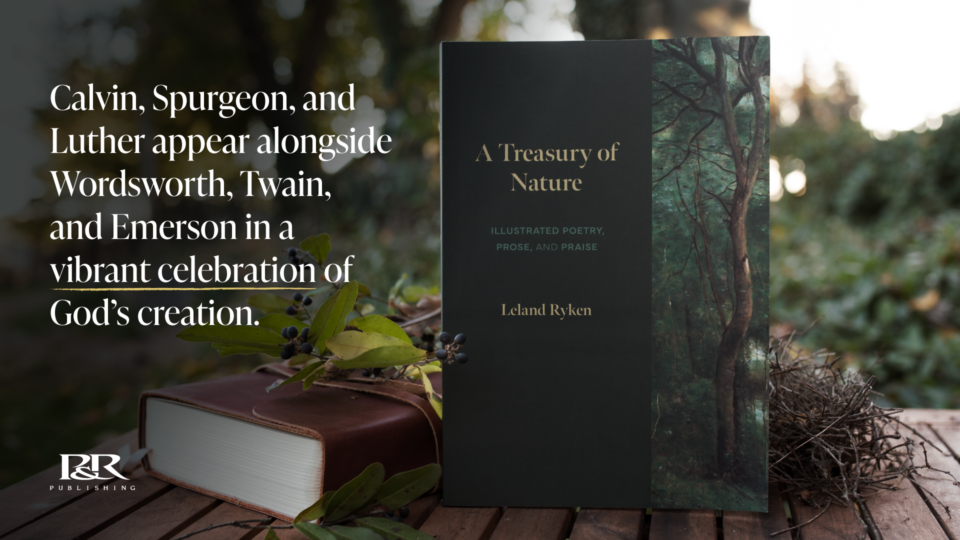
“As we read the entries in this anthology, we are helped by taking a trip back in time to the contemplative exercises of the Middle Ages. These exercises began with ‘composing the scene’: imagining oneself as present at an event in the Bible. One then subjected the scene to analysis with the goal of understanding it fully. Finally, one reached closure, usually either by turning to God in prayer or by codifying what today we call an action plan or statement of resolve to act.”
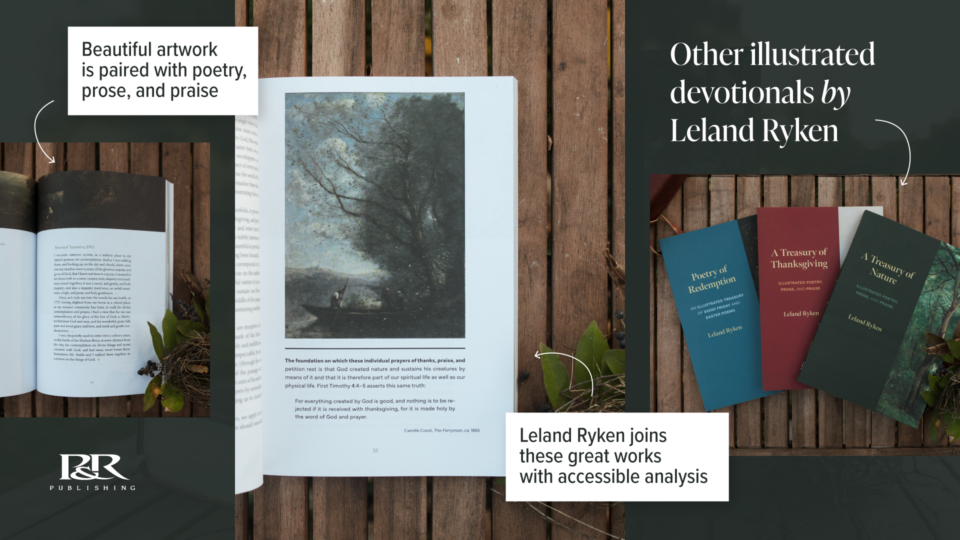
Other Illustrated Devotionals by Leland Ryken
A Treasury of Thanksgiving: Giving thanks to God is a yearlong Christian practice. In this lavishly illustrated anthology, Leland Ryken presents forty of the greatest, most enduring thanksgiving texts of the English-speaking world—including Scripture, hymns, and prose—with helpful commentary and devotional remarks.
Poetry of Redemption: The works of poets such as John Milton and Christina Rosetti and hymnists such as Isaac Watts and Fanny Crosby unite with the poetic testimony of Scripture in this anthology. Forty meditative readings present their work alongside literary explanations from author Leland Ryken. Accompanied by beautiful artwork (none shows Christ’s face), they are designed to fix our thoughts on God and the spiritual life and to awaken our religious affections.

 This week the blog is sponsored by Redeemer University. Choosing a university amidst the rising cost of living, rapid technological advancement, a changing job market, and a polarized, increasingly secular cultural context can be a daunting decision for Christians. The world is also much noisier than it was for previous generations, oversaturated with messages urging young adults to read this, watch that, comment, get involved, fight for justice, tell your story, get a job, chase your dreams, be authentic, reach for success… change the world! Many of these messages strike a chord, but the noise can be overwhelming. Let’s turn down the volume for a minute. What if there was a place for the next generation to figure out what they like and are good at? A place to ask big questions like, does my faith matter when it comes to business or science, media or politics, social work, health, music, art, history or education? Is there a place that prepares young adults for their future career, where they can learn inside and outside the classroom and are a part of a community that lives and thinks together, worships, plays, laughs and even struggles together? Redeemer University is that place. A place to quiet the noise and listen for God’s calling, explore what that looks like in many disciplines, get ready for the future and grow in faith through it all. Perhaps you’ve never heard of Redeemer University or know very little. It’s the largest Reformed University in Canada, with nearly 1100 students, six undergraduate…]]>
This week the blog is sponsored by Redeemer University. Choosing a university amidst the rising cost of living, rapid technological advancement, a changing job market, and a polarized, increasingly secular cultural context can be a daunting decision for Christians. The world is also much noisier than it was for previous generations, oversaturated with messages urging young adults to read this, watch that, comment, get involved, fight for justice, tell your story, get a job, chase your dreams, be authentic, reach for success… change the world! Many of these messages strike a chord, but the noise can be overwhelming. Let’s turn down the volume for a minute. What if there was a place for the next generation to figure out what they like and are good at? A place to ask big questions like, does my faith matter when it comes to business or science, media or politics, social work, health, music, art, history or education? Is there a place that prepares young adults for their future career, where they can learn inside and outside the classroom and are a part of a community that lives and thinks together, worships, plays, laughs and even struggles together? Redeemer University is that place. A place to quiet the noise and listen for God’s calling, explore what that looks like in many disciplines, get ready for the future and grow in faith through it all. Perhaps you’ve never heard of Redeemer University or know very little. It’s the largest Reformed University in Canada, with nearly 1100 students, six undergraduate…]]>
This week the blog is sponsored by Redeemer University.
Choosing a university amidst the rising cost of living, rapid technological advancement, a changing job market, and a polarized, increasingly secular cultural context can be a daunting decision for Christians. The world is also much noisier than it was for previous generations, oversaturated with messages urging young adults to read this, watch that, comment, get involved, fight for justice, tell your story, get a job, chase your dreams, be authentic, reach for success… change the world!
Many of these messages strike a chord, but the noise can be overwhelming. Let’s turn down the volume for a minute.
What if there was a place for the next generation to figure out what they like and are good at? A place to ask big questions like, does my faith matter when it comes to business or science, media or politics, social work, health, music, art, history or education?
Is there a place that prepares young adults for their future career, where they can learn inside and outside the classroom and are a part of a community that lives and thinks together, worships, plays, laughs and even struggles together?
Redeemer University is that place. A place to quiet the noise and listen for God’s calling, explore what that looks like in many disciplines, get ready for the future and grow in faith through it all.
Perhaps you’ve never heard of Redeemer University or know very little. It’s the largest Reformed University in Canada, with nearly 1100 students, six undergraduate degree options and 35 majors and streams. Distinct from bible colleges and seminaries, Redeemer offers programs in the social sciences, the humanities, business, the natural sciences and mathematics. Redeemer also seeks to meet the needs of the wider Christian community through certificate programs and microcredentials and is planning to launch graduate degrees in 2026.
Rooted deeply in the Reformed tradition, Redeemer students, faculty and staff come from over 45 denominations. This unique and spiritually vibrant academic community is unified by a commitment to the authority of Scripture and a comprehensive biblical worldview. The perspective that Jesus Christ is Lord of every square inch permeates the entire Redeemer experience as we are called to join his redemptive work in every area of creation.
Located in Hamilton, Ontario, Canada on a beautiful 86-acre campus, Redeemer is only 45 minutes west of Toronto, and Buffalo, NY, is less than an hour to the southeast.
Many might assume that affordability is out of the picture. With the help of its generous donor community, Redeemer is committed to affordable tuition which is currently under $10,000 CDN (roughly $7422 USD). In Canada, that is comparable to a public university education and less than the cost of many private Christian elementary and high schools.
Today’s students are being pulled in a hundred different directions as they try to make sense of their purpose and future. At Redeemer, faith is woven through all aspects of learning and life to create a transformative academic experience that prepares students to reflect the love of Jesus Christ in every career and calling.
Explore highlights from the 2023-2024 academic year in Redeemer University’s online, interactive Annual Report.
Come for a visit and see for yourself. Ready to take the next step? You can apply online.
]]>